#another post making a slightly different variation of the same point that's been made a thousand times
Explore tagged Tumblr posts
Text
Yes, President Snow tried to make the people of Panem focus on Katniss and Peeta's love story to keep them from focusing on the rebellion. But that doesn't mean the love story doesn't matter. The irony at the heart of the Hunger Games trilogy is that the Capitol thought the love story was pointless, but it was actually the entire point all along.
President Snow tried to frame Katniss and Peeta's act of love--trying to die for each other--as something irrational. No sensible person would do anything so stupid and rebellious! They only did it because love puts you out of your right mind! Emotions make you irrational and unpredictable, a danger to yourself and others! Falling in love turns you into a fool--only following the rational ideas of the Capitol will keep you and your families safe from the irrational effects of love.
Unfortunately for him, the audience begins to see that the foolishness of love is wiser than the Capitol's wisdom. A society where emotions can flourish, where people can act selflessly, where children are cared for, enemies are honored (or at least treated as people), and other people are worth dying for, might require more trust, might require you to risk yourself, but it makes for a much more beautiful world than the rational oppression of life under the Capitol's rule.
Snow thought that a love story would prove to the people how important their society was. He thought it could distract from revolution, because he couldn't see the deeper truth.
In a society built upon the principle of kill-or-be-killed, love is the revolution.
#the hunger games#suzanne collins#another post making a slightly different variation of the same point that's been made a thousand times#but i've just seen a few dozen too many takes like#'the capitol tried to distract people with the love story'#'and now people focus on thg's love story instead of the revolution part so we're just like the capitol!'#i get that they're criticizing shallow surface reads of the story#that care about the aesthetic and emotions above any deeper message#it doesn't mean that their phrasing isn't annoying and wrong
374 notes
·
View notes
Note
You mentioned this in a post reply that made me remember I meant to ask (as always, just point me if you have already spoken about this): opinion on Agamemnon and Clytemnestra's daughtes?
In the Iliad I seem to remember three daughters are mentioned, Iphianassa, Laodice and Chrysothemis, while in the plays they are usually Iphigenia, Electra and Chrysothemis (bless her unchanging name).
Do you identify Iphianassa as Iphigenia and Laodice as Electra? Or do you prefer them being all different people?
So often female names (not only here) are conflated, recording people probably didn't care enough about them to be precise about it :(
I think mentioning Iphianassa in the Iliad (in the context of being offered in marriage to Achilles) suggests that in that early tradition the sacrifice of one of Agamemnon's daughter had not been added to the canon, both because Iphianassa could be the same of Iphigenia and thus still alive and because offering a daughter in marriage to Achilles after the last time he was 'bethroted' to one ended up being a sham would be tactless to say the least (and Achilles is just so sensitive about honor and pride).
Plus there is that Iliad line listing the throne passing from Atreus to Thyestes to Aga without mentioning the horrors™️, which with Iphianassa being alive could mean at that point of the traditions Agamemnon was just a commander and not the last scion of an extremely cursed royal line.
...unless Homer is alluding stuff that the audience is already supposed to know and offering another daughter to Achilles was meant to make up for that whole fiasco (unmentioned in the Iliad)?
The notes on my Iliad say that the 'embassy to Achilles' chapter may even be a slightly later addition (like possibly the night raid chapter) since later part of the story proceeds like it didn't happen, so this all is speculative squared ahah
Yes I have had a talk with @emmikay in fact on one of my posts about contradicting sources and you can see my reply here:
But the subject is always fascinating!!!!
As I mention to that reply of mine, it is hard to tell whether we speak for example on Iphianassa as the same person as Iphigenia or if it is a different daughter that kinda got lost as a version in the centuries and eventually the two names were used interchangeably for the same person. It is also possible, as I mentioned to that reply of mine, that Agamemnon is insinuating the substitution of his daughter with a fawn as a homeric tradition thus if "Iphianassa" and "Iphigenia" are one and the same person then Agamemnon insinuates a "happy ending" to the tragedy of Iphigenia and her sacrifice (as I mentioned to my reply and that Agamemnon Analysis, the essence of Agamemnon lashing out to Calchas seems to be indicating that Aulis incident is a homeric tradition given how Agamemnon doesn't fully elaborate as to why Calchas "never had a good prediction for him" as opposed to the idea of later on suggesting the marriage of Achilles to "Iphianassa"
Iphianassa seems to be simply an old variation of the name "Iphigenia" given how similar the names are (as opposed to "Laodice" for example) and both seem to be insinuating her noble birth as "Iphi" stands for "strong" (Another character in mythology that has it is for example Heracles's brother Iphicles) and "anassa" means "queen" while "genia" implies "bloodline" so she is named either "Strong Queen" or "Of strong Bloodline". Either way the names seem to be similar so it does seem at times that it is a variant of the same name, although the actual possibility of that being the name of another daughter of Agamemnon seems to be on the table I would lean more towards the first idea, that it is a variation or alternative (one can even blame the metric system in Homer that required the syllables of the name to fit his metric poem) given the lack of sources indicating otherwise.
Frazer for instance supports the idea that Homer didn't know the sacrifice tradition yet or doesn't quote it (explaining the existence of the betrothal with Iphianassa in the Iliad) or that the name Electra was unknown to him but I disagree with the first mainly because of the passage that as I said Agamemnon claims in distress that Calchas always has a bad prophecy for him. It is the second part that I am mostly intrigued by. As to whether Laodice and Electra are the same person or if they are two different traditions. Given how "Laodice" translates roughly as "people's judgement" seems pretty royal name to give. Whilst "Electra" simply means "Amber" or "Of amber color"
I am actually taking a leap here but I feel like Laodice was the name given to her at birth but "Electra" was a nickname given to her because of the color of her eyes or hair or both, pretty similar how Neoptolemus is nicknamed such ("new warrior" or "new conqueror") by Phoenix. In my brain it creates a fine parallel between Achilles and Agamemnon through their children, how their children have a different name by birth and got known later on by another. Of course I have no actual proof on this but it also seems to me like a parallel with Electra's tragedy as well given how Electra brings "justice" or "judgement" upon Clytemnestra later on.
Actually...no offense but I kinda am not fond of this interpretation dunno why, when we always say "they didn't care for female characters thus the names change" because honestly I think it is unfair. We have unchanging or relatively steady names of main female characters in mythology (Helen, Clytemnestra, Penelope, Chrysothemis etc) while others change depending on tradition, local names or history etc. With the same logic why aren't we promoting more that mythology "hates men" when out of the 108 suitors of Penelope only around 20 are named in the Odyssey and out of the 600 men of Odysseus only a handful are named or why aren't we speaking on "erasure of humanity" of characters that their name allegedly changed such as Lygiron being Achilles's original name or Alcides of Heracles etc. I understand of course where the idea and the interpretation comes from but honestly in a world of myths where women play a deuteragonistic role we often see names change indeed but so we do with men who are oftentimes not named at all when they play deuteragonistic role or their origins are misread or misinterpreted or confused or oftentimes is hard to tell who is who (Like Eurybates in Iliad and in Odyssey being unclear if he is the same person or different etc) Hehehe sorry parenthesis closed! back to the original point! -that is just me interpreting it by the way. It doesn't need to be more correct than the interpretation you give, it is just that it is my opinion in regards to the matter that we do not need to see "erasure of women" everywhere. Just that deuteragonists in a story often are indeed not steady or omitted unfortunately-
Anyways moving on; For the line of Atreus and Thyestes not implying the violence in the whole thing seems to me very similar to how the violence of the downfall of Tydeus is not touched in Homer. Tydeus's cannibalism which was the reson of his doom was never mentioned in Homer. If anything Tydeus is being praised throughout the poem and compared with his son. Similarly the way the line of succession between Agamemnon and Thyestes is not mentioned or touched upon can mean to me
It is not directly related to the story and potentially already known and spoken tradition that doesn't require much explaining
Creates character realism, given how the last thing Agamemnon or any of his peers would need would be to mention a story of betrayal and cannibalism before the army.
As you state later, Homer could easily be citing events that most of his readers and listeners already knew too well or were at least familiar with, so he didn't feel the need to elaborate further. The second is that it seems natural for the characters who aim for glory not to mention the least glorifying things of their past because the point would be for the heroes to be seen in battle as they are now and in one way the way that Iliad seems to be creating the pattern of "glorious men that try to reach and surpass the glory of their families" doesn't correspond with the monstrous details of their pasts. But also as I said their past or family lines are not directly linked to the story so they are not given much mention. For example the mention of the coup Hera made IS made mention in the Iliad because it was important for the pleading Thetis made to Zeus.
Of course the possibility any of these traditions not being part of Homeric story and lore or even not be invented till later on is always on the table but personally I like to think that a large number of these were rejected because the story didn't call for them and they had different focus.
Honestly if I had a dime every time we had a theory about this or that part of Homer being "later addition" or "being written by a different writer" came out I would be rich! Hahahaha jokes aside though even if it is valid critisism and a very valid point I kinda do not align with it. Maybe I am too biased with Homer or my own idea that Homer is one writer and that the poem seeming seamless to me but still I am not sure why would that prove the "later adition" thing. Many events in Homer do appear and then they are not mentioned again because they are not relevant to the next parts of the story. See for example the obvious strong bond created between Telemachus and Nestor's son Peisistratus which was mentioned thoroughly during the trip in Telemacheia and never was mentioned again Telemachus mentions his trip to Pylos but never mentions "I made a friend along the way" because it was not THAT strongly relevant to the story which was the purpose of Telemachus being on a cognitive trip to find information on his father. We also do not see much on Helen mentioning the horse ever again even if that seems to be critical to the story of Troy, it is not directly linked to the Odyssey or the messages it wanted to pass. The fight with Irus is not mentioned again in the Odyssey as if it never happened even if it was also another clear event that Odysseus proved his strength and was one of the first steps towards recognition with the suitors etc. The events that are directly mentioned on are usually the ones directly linked to the story (for example Polyphemus, Circe, Calypso etc or in Iliad the taking of Briseis, the wounding of certain heroes or the killing of others and the fear of the people related to them)
Certain events in the Iliad and the Odyssey are being mentioned before (see for example how Diomedes and Odysseus and Agamemnon are wounded in later rhapsodies after rhapsody 11 because their wounds are actually relevant to the story and the way it moves at that spot) as opposed to the one failed attempt to bring Achilles to battle at first. It doesn't seem to be offering any news to the story if Odysseus came out and said "here we are again to you Achilles" given how the reader and viewer already knows that we have an embassy or rather the attempt to give gifts to Achilles when Achilles lets go of his anger free of charge to Agamemnon.
But I agree it is all speculative given the lack of any other information apart from readings and speculations of other writers and scholiasts (ancient or contemporary) which is why the mystery behind the identity or lack of it of Homer is still on and open for discussion.
Hahahaha gosh this got massively long! Hahaha I am sorry! I would love to hear some of your thoughts onto mine! ^_^
#katerinaaqu answers#greek mythology#tagamemnon#homeric poems#homeric epics#the iliad#the odyssey#agamemnon#laodice#electra#chrysothemis#iphigenia#iphianassa#names and events in homer
20 notes
·
View notes
Text
The Avengers: Double Danger

This is another series 1 episode of The Avengers which no longer exists. You can read a summary of the plot and two different revisions of the script here: https://dissolute.com.au/the-avengers-tv-series/series-1/118-double-danger.html This blog post is simply based around the original camera script, which I have read, and not Lucarotti's revised version, which I have not. The two variations of the script and the show being junked mean that there is a lot of confusion online about this, which I intend to add to with this post. Of course I'm also thinking that when I've read the revised script I could do another blog post if the mood takes me.
This is absolutely not a criticism but part of the confusion comes from the rather involved plot of this episode. To cut to the chase, a man who has stolen some diamonds and hidden them is assisted to escape from prison (this turns out to have been arranged by Steed), only to be shot by a rival gang. Dr Keel is forced to give him medical help before he dies of the wound, and the rest of the episode revolves around following the clues as to where he has hidden the diamonds and the ongoing double crosses between the two groups (who form the double danger of the title) looking for the diamonds. In fact at one point Steed says,
'Mace double crossed Bruton. And Mrs Mace double crossed her husband. Then you double crossed Bruton. And Bruton double crossed you. It's almost as complicated a politics.'
I don't, however want to give the impression that this plot is unnecessarily complicated. It is, of course, complicated and confusing, but I honestly think that's the point. I found the script a real page turner as I was reading it, and honestly this is the first series 1 episode that I've been able to say that about. By the end of it you don't know what's going on, but it's a nice confusion.
If that makes it sound like a farce, frankly I have found myself wondering whether that was intentional. I found myself laughing out loud as I was reading it on the canal bank this afternoon. However I have been unable to work out whether anyone else approaches the episode like this or if it was intended to be funny, because the online commentary is rather limited. I would love to hear if anyone else has found it funny.
In reality it almost certainly wasn't intended to be funny because the episode is very much one of the early two-against-the-underworld episodes. And they are very much up against the violent underworld, people who don't mind killing for diamonds, here. It raises intriguing questions about who or what Steed is, because he is clearly posing as an underworld fixer in arranging an escape from prison. However he says that he is arranging this on behalf of the insurance company who had insured the vanished diamonds. This is clearly a lurch into the classic Avengers unreality, because this seems an unnecessarily cloak and dagger way for an insurance company to carry on business. It is also clear that this is officially sanctioned because Steed communicates with his series one boss. Yet at the same time Steed is keen that Keel doesn't reveal his involvement in this to the police. Whether as merely a tactic to stop the inevitable complications caused by the constabulary or whether he is being slightly underhand, is not made clear. The questions it raised about Steed in my mind were one the things I most appreciated about it.
Double Danger was also a new experience (to me) because it was the first I have read where a significant role is given to Keel's assistant in the surgery, Carol Wilson, played by Ingrid Hafner. I tend to forget that the original intention was that Carol and Keel would be the two against the underworld but Steed somehow intruded into it. This episode is an interesting reminder of the original pairing; although notably it is Steed that Keel tells Carol to contact when it becomes clear to him that he is in trouble.
He communicates with her in a most fascinating way which I really don't think you would find on TV nowadays. The second set of villains have tricked him into being obliged to give medical help to the shot diamond thief, despite him telling them that he should really be in hospital. One of the gang goes back to the surgery with a list to give to Carol of things that Keel will need to try to keep the man alive. At the bottom of the list is the strange phrase 'Fonum equus', which Carol tells him is some medical preparation. Of course it is really pretend Latin for 'Phone the horse,' or rather Steed!
If you particularly want a criticism it is that you might find the light touch of this episode, verging on the humorous, incongruent with the weighty subject matter, which is otherwise a straightforward tale of crime and double crossing. Although I think it would be churlish to criticise.
This is another excellent series 1 episode of The Avengers which I would encourage readers to seek out, either in script form or the series of audio recordings by Big Finish.
This blog is mirrored at
culttvblog.tumblr.com/archive (from September 2023) and culttvblog.substack.com (from January 2023 and where you can subscribe by email)
Archives from 2013 to September 2023 may be found at culttvblog.blogspot.com and there is an index to the tags used on the Tumblr version at https://www.tumblr.com/culttvblog/729194158177370112/this-blog
0 notes
Photo

Day 115: Tuesday April 25, 2023 - “Babies Mamas”
This post contributed by Audrie after hosting a pool party with her baby mamas:
I am so grateful for these women. Kate and Bre. They both are saved in my phone contacts with “Stella” and “Otis” attached respectfully. We all met about 18 or so months ago at the Birth-Center-Mom-Baby group. Stella was just a little sprout and Otis had to have been closing in on 7-9 months, William in 4-6 month range, and I just latched on to the positive energy of these two.
Out of all the women, and all the children, I knew Bre and Kate could be my tribe. It wasn’t more than a few words after hearing Kate & Stellz’s dad were from the STL, that I suggested beers at the brewery and invited a friendship that went beyond Friday’s at the Babymoon.
The rest is history. We co-encountered and co-conquer all the variations of sleep regressions, teething tenuousnesses, food introductions, and developmental milestone markers along side one another while strolling the zoo, group texting or sneaking away for mamas-only-night at the comedy club.
Then suddenly Bre and Tom were unexpectedly expecting a second baby and Kate and I didn’t hesitate to throw a warm welcome sprinkle-shower for baby E.
These women have been my go to for mom-talk, ladies nights, and just over all steadfast rocks to recenter on and cling to when the waters became too murky and rough to navigate solo.
These two were always on standby to hoist me back up when the slippery sloping edge that is new-motherhood got too steep to navigate alone.
I love them, and their babies. And we don’t all get together as often as we all would like, or connect as much as we all wish we could to let the kids bond, and the wine and whines flow. And yet, it’s been enough to not ever forget the value of this band of new mamas and the impertinent asset of having a few good women in your corner; walking a journey not exactly right along with you but somewhere…as if on a similar trail…within the same rough square mile of foreign landscapes and wild places…. A square mile made up of rock, and wash gullies, dehydrated shrubbery, and random wondering useless cows.
These women have been a lot like fellow desert hikers: picking their way from the tattered ends of the long dirt road that goes over the grand escalate staircase, and then diverges like the Nile’s Delta into the randomly-organized maze of trails that weave and wonder their way up to the backside of Lake Powell.
We are all out here looking for the golden goose— that amber glazed sunrise donut reflecting off the red rock and glassy still water in Reflection Canyon. We are all seeking that piece of peace. Whether it’s in the wild or it’s in the wildness of the child, we are all set to conquer the peace.
In preparation for the journey, someone might have given you their compass, or their recollection of the way along that similar excursion that they hiked years ago… but until you are in it yourself, and realize we are all on a journey aimed at the same destination, but true north will point in different directions in the same compass for for each mama and child — we all have a yearning for the the prize of that award winning son-rise: a happy and healthy child, a thriving and not-crying and peacefully-sleeping-not-weeping-tiny-human that is not just the product of our cell building and milk rearing, but also our decision making and pathway picking though the neural-network map of endlessly possible passages to the sweet water’s edge.
This singular journey that pushes back and dances with the banks of insanity, also brings grounding and recenter in the small moments with the mamas who cross paths, who find their tribe on this solo journey; who take shelter under the same shade tree, together to breathe, to share, to reflect and to project and then to continue on again, in our slightly different directions and at different paces —yet all arrows aimed to arrive collected again. Down the trail. We all want the waters’ edge. The peace the love the beauty of a contended child, the warmth, the joy, the gratitude reflecting back in that baby’s smile.
We collected under a shade tree again today, Bre, Kate and I. And in the cooling waters of the Finca’s back yard, our hands stayed busy, while our hearts slowed down— for at least a few fleeting moments we rested our mama-souls. Leaning into one another, affirming, praising and recollect.
It’s never enough, and it’s also always just enough time with these women, and our babies.
Song: Mazey Haze - Back to the Start
Quote: "What we know of other people is only our memory of the moments during which we knew them. And they have changed since then. To pretend that they and we are the same is a useful and convenient social convention which must sometimes be broken. We must remember that at every meeting we are meeting a stranger." ~T.S. Eliot
1 note
·
View note
Photo
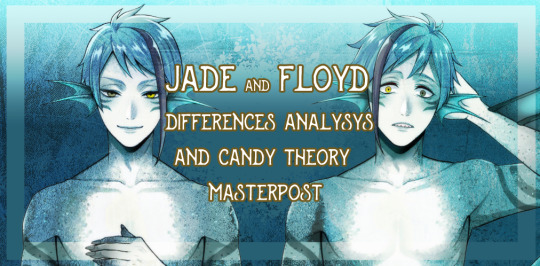
since my only real contribution to this fandom has been thedifferences analysis i did with my friends i think it’s time to separate it from the AU post and make it into a real masterpost, this is gonna be pretty long so be ready for it Disclaimer: models and art are fluctuating so i’m going to highlight only the recurrent stuff and the related evidence for the candy theory, so i’m not claiming this to be the indiscutible canon so take this evidence as you polease, just know it’s there but going forward....it’s time to begin with a few copy and paste from the previous posts with a few corrections along the way What is the candy theory? the Candy theory generates by the names of their alchemy lesson candies, according to it, they highlight their strenghts/charm points so Tail Fin Candy for floyd meaning legs and height and Dorsal Fin Candy for jade focusing more on his torso/back i’ve seen many people comapring sprites to prove this theory on twitter so it’s time to show some examples, i tried to recreate them as best as i could (consider as i said art tend to be a lil less reliable than spites as it heavily depends on the lineart artist who’s assigned to the job)

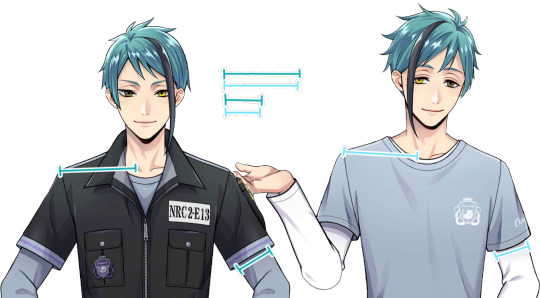

this repeats in pretty much all the versions aside the mermaid sprites that are copy/pasted BUT on that someone call in the octavinelle trailer to support the theory

some also link that to floyd possibly being a late bloomer as we clearly see baby floyd was indeed shorter than baby jade in middle school even without the aid of guiding lines
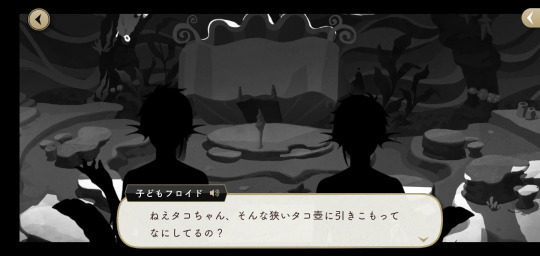
both the tweels are of course still growing, since despite being GIANTS they are afterall still 17 but we heard a detail from floyd unique from what we know about jade, In floyd’s starsending episode translated by Ekala he states that

to adjust the mold of custom made shoes he has probably gotten considerably taller within the year
According to some this means that floyd’s uniforms aren’t short on purpose but are simply his first year ones and hedidn’t change them...but in that case jade wouldn’t have grown much in height... according to these theories then floyd “just started” getting his growth spurt while jade is pretty much settling his height and frame, but considering his apetite i wouldn’t be surprised to see himweighting more than floyd if we wver get an official weight for the boys(as we do know trey weights less than rook etc) but we are swimming too much in headcanon waters let’s proceed with the analysis in the previous posts these were the differences that emerged some of them are based on artwork so i’d take them with a lil caution especially on the topic of the hands that proved to be especially unreliable (floyd even got them changed in one of his sprites cause they looked too soft , sometimes jade has softer hands too) shoulders seem to be fluctuating as well

starting with some artwork analysis in the magic archives we get a view of the eels from the back, and floyd was the only one with sketch underline, this was the result considering jade and azul wearing clothes properly (and even pretty tight in jade’s case as we saw before)

further update to support the theory comes from the Union Birthday model atlases starting with the difference in rendering of their vests that being the same shape have some pretty distinct rendering on the contrary of the usual ( mermaid copy/paste-very similar halloween) as in jade we even find back the return of the button crying for help
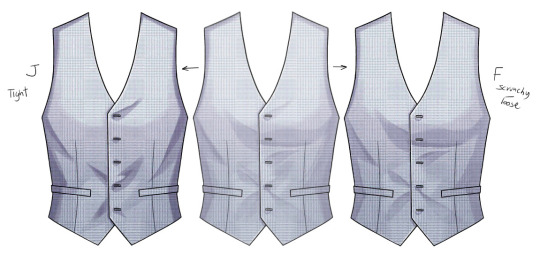
another element is the belt as all the models come with a separate belt but i decided to merge it with their hips to give better context as there’s no variation in the legs and as usual floyd’s are slightly thicker but something we never analized surfaces here , and i think there’s not even need to explain this

some relate this to their first bday art too even if their model don’t show significant difference
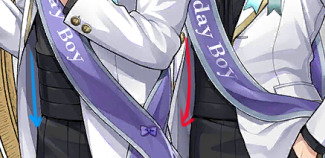


also in mer-form when having the same position you can see another visible difference between jade and floyd

in the masterchef ones we see pretty much we see a similar thing to the birthday boy vests even if shoulders and waist are pretty much the same they still keep a small but consistent difference
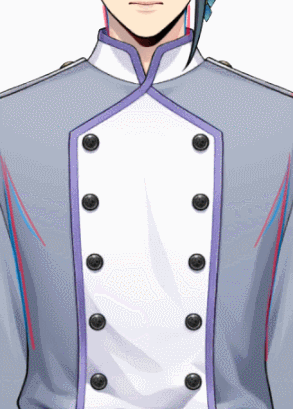
before jumping to the “it’s just the clothes” bandwagon i remind you that once again jade wears skin tight clothing and floyd loose/oversized stuff

this pic actually leads us to the latest difference found aka the forearms always from the masterchef models
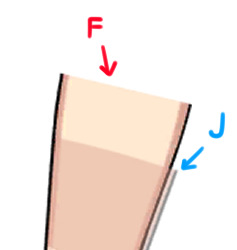
i hope to update this masterpost next month with their proper leg difference with floyd’s basketball club wear coming out to compare with jade’s vargas camp leggies so yes apparently jade’s the titty twin and floyd the ass one, and you may wonder wasn’t jade the ass one? i am afraid to break it to you but his beansday backside is fake af and all thanks to the harness

in conclusion these are the predominant differences it’s also left to dind the difference that rwas mentioned to riddle about the fact that ears are also different but the art is inconsistent on that matter and we didn’t come to a proper solution and it might be something only perceived by the characters
352 notes
·
View notes
Text
You’re (Probably) Drawing Archers Wrong
Hello, my name is Len and I’ve shot archery as a hobby for as long as I can remember. I have a problem: fanart depicting archery is oftentimes Very Wrong! I feel like most of this stems from not using good reference pictures, and from a general lack of knowledge. So, I wanted to create a post for anyone interested in accurately drawing an archer! Disclaimer: this is not a comprehensive post or a tutorial on how to shoot, and is intended for artists. That said, if you’re interested in archery, you may still find value in this post, though I recommend doing your own research. I’m certain there will be errors here considering I do this as a hobby not a profession, and I welcome corrections. Finally, archery can be dangerous, and even if you don’t read any more of this post, PLEASE read the safety section.
Safety
This part is going to be a PSA, because the thought of someone reading my post, getting into archery themselves, and doing these things? It terrifies me. So, rules number one, two, and three are: never aim at another person (duh), never use a damaged bow or arrows, and never, NEVER dry fire a bow. Dry firing means drawing back and releasing the string without an arrow. This can make your bow EXPLODE. It can hurt you, and even if your bow doesn’t explode, it’s fucked it up so bad that you should never shoot that bow again. Don’t do it, and don’t draw art of people doing it. Okay, PSA done, now onto the rest of the post.
There’s a TL;DR at the bottom!
First thing’s fist: the equipment! Archery requires four things: a bow, a quiver, arrows, and protective equipment (which is usually what I see most posts lacking). The first thing you should do before you draw your archer is decide what type of bow to give them. I’m not covering crossbows because I’ve only shot one once and I also Hate Them. There are three main types of bows: longbows, recurves, and compounds.
Bows
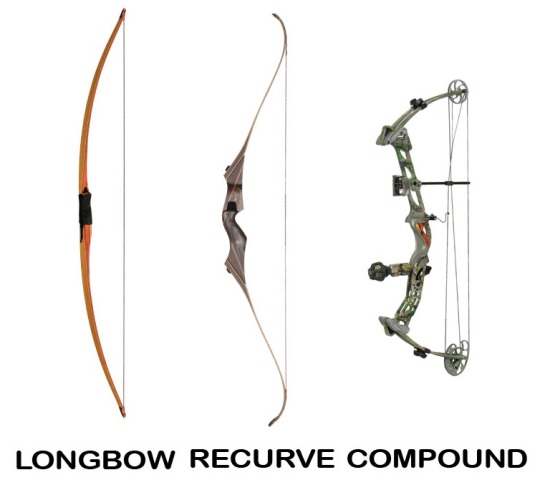
There are two different types of bows that are commonly called a longbow: English longbows, and flatbows (yes I’m considering flatbows a type of longbow to simplify things). English longbows are very large and have a very high draw weight (which means it’s hard to pull the sting back). These were used mainly by the English in the Middle Ages. Flatbows are typically smaller and have a lower draw weight as well as a slightly different profile. These were mainly used by Native American tribes such as the Hupa, the Karuk, and the Wampanoag, as well as prehistoric Europeans and the Finnish, among others. It is often seen in historical fiction and fantasy, and the English longbow is usually depicted as Robin Hood’s preferred bow type. I believe Katniss uses a flatbow in the beginning of Hunger Games, but don’t quote me on that.
Recurves have limbs that curve outwards and are smaller than longbows. Many, many cultures have used these, including but not limited to certain West-coast Native American tribes, the Mongols, the Scythians, the Greeks, the Turks, the Koreans, and the Chinese. Recurves can be made of either wood or of a combination of wood, horn, and glue, making them either composite or non-composite. These are the bows you typically see mounted archers using, and are often used in competitions today. It’s commonly seen in fantasy, and is the bow type used by Legolas, Tauriel, Katniss Everdeen in Mockingjay, Merida, Green Arrow has a lever action, and Hawkeye uses a silly collapsible one.
Compound bows are the most commonly used bow among hunters, are almost always made of fiberglass and either carbon fiber or aluminum, are Technical Looking, and pack the biggest punch for the least amount of effort. It’s a modern invention used worldwide. I don’t know where else to put this, but almost everyone who I know that shoots a compound uses something called a trigger release (pictured below) to draw back the string because it means your release is cleaner.
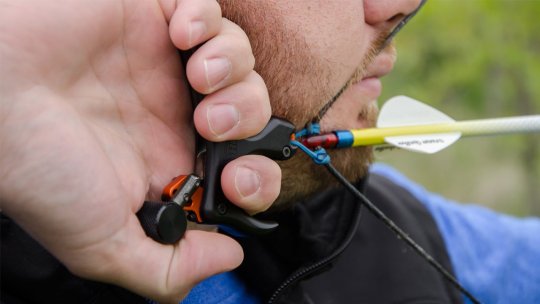
So, those are the main types of bow! Google which bow would be appropriat for the era and region your character is from, or if they’re from space or an alternate dimension, pick whichever you think fits the character the best.
Quivers
There are two types of quiver: back quivers, like Legolas wears, and hip quivers, like those used in the Olympics. Which quiver you should use varies from culture to culture and time period to time period. If it’s fantasy, set in modern day, or set in the future, you can chose whichever you prefer.
Arrows
Arrows can have shafts of wood or fiberglass, can have real feathers or synthetic for fletching, and can have countless different types of heads. The main two that are in use today are called field points and broadheads, and most commercial arrow shafts allow you to freely switch them out.
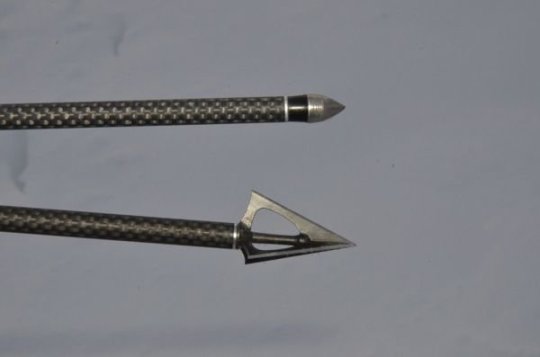
The arrow on the top is a field point, used only for target practice, and the arrow on the bottom is a broadhead, used only for hunting or war. You never hunt with a field point, and never practice with a broadhead. Basically every fictional character out there is shooting to kill, so they’ll all use either a broadhead, or a culturally appropriate variation of deadly arrowhead (bodkin, scythian, flint, etc). Do your research! A Native American wouldn’t use a bodkin, and a Scythian wouldn’t use a flint arrowhead!
Protective Equipment
The one really necessary piece of protective equipment is hand protection. If your character uses a three fingered draw or a pinch draw (we’ll speak on draws later), they need either an archery tab, or an archery glove. If your character is using a thumb draw, they need a thumb ring. These three pieces of equipment keep archers from getting blisters and damaged skin.
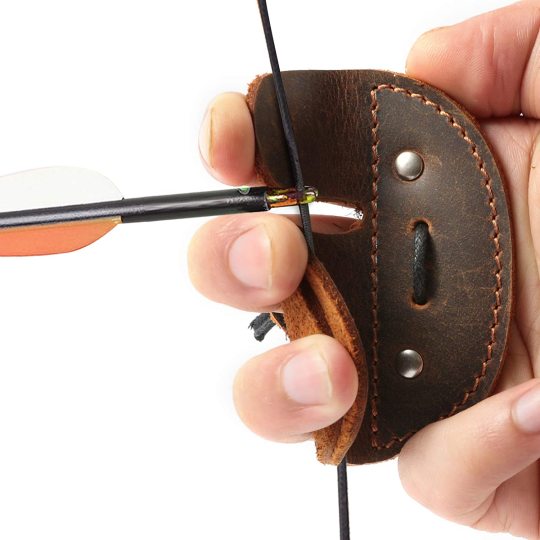
This is a tab.
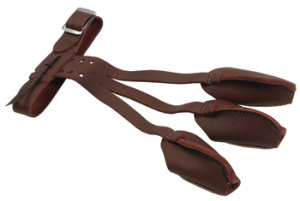
This is the type of glove that I use. All an archery glove needs to do is protect your three draw fingers, but it can be more traditionally glove-like than this one. I’ve even seen ones that are a combination leather bracer and archery glove that give big Fantasy Vibes.
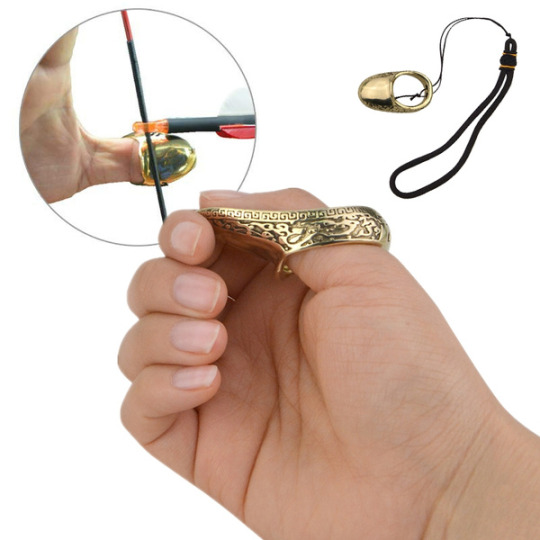
This is a ring. Some historical ones can get REAL ornate and pretty.
Another piece of protective equipment that is commonly used is an arm guard or a bracer. Not everyone uses one, because if your form is good the string should not be hitting your arm, so you can get away with not giving your character one. They can vary in style from something like the more minimal one below up to a full leather bracer.

Form
Form can vary greatly and I’m not about to diss other archery disciplines especially ones I’m ignorant on, so just know that not every culture has the same form. I’m just going to cover a few cultures’ variations, and what I’ve been taught by 21st century Midwest archers. There are several aspects to form, as form is just another term for “everything pertaining to how you shoot”. I’m going to break it down into stance, posture, draw, elbow discipline, holding the bow, and anchor. These are not the only aspects of form (there’s aiming, release, and breath control), but these are the only relevant aspects to drawing archers. I will not be covering mounted archery because I’m sadly ignorant on the topic. I recommend doing your own research and looking into Mongolian mounted archery.
Stance
The thing all stances have in common is that you should put your feet a shoulder-length apart, balance your weight equally between both feet, keep your knees slightly bent, and stand facing approximately 90 degrees away from your target. There are three stances that are common that I’m aware of: squared, open, and closed.

Squared stance means keeping both feet squared up to an imaginary line. Open means that you’re facing slightly towards the target. Closed means you’re facing slightly away. I vary between square and open, and to be honest I’ve never noticed a difference. So long as you draw your character standing with a stable stance, facing away from the target, you should be good.
Posture
Your posture should be with your back straight, your hips squared, and should never have you leaning. Below is one of my favorite archery pictures, not only because I love Marilyn, but because it is a great illustration of what not to do posture wise.

See how she’s leaning back? Yeah, don’t draw your character like that, it looks foolish.
Draw
There are four different types of draw that I’m aware of, I’m educated on three, and I have experience with one (though I’m itching to learn to thumb draw). The types of draw are three fingered draw, otherwise known as Mediterranean draw, pinch draw, thumb draw aka Mongolian draw, and Japanese draw, or torikake. I know fuck all about Japanese draws, so I’m not going to speak out of my ass on topics I don’t understand (if anyone reading practices traditional Japanese archery I would love if you chimed in!). I highly recommend doing your own research on which civilization your character comes from and which draw they use, especially if it’s Japanese because I’m not covering that here.

First up is three-fingered. This is the draw I use, and it’s the most common draw in my limited experience in the Midwestern archery community. It is common in Europe and the Middle East. It requires you to use three fingers, partially wrapped around the string. You do not pinch the arrow. Most people place their index finger above the arrow and their middle and ring finger below, though I’ve seen all different variations. If your character is right handed and uses this draw, draw the arrow on the left side of the bow. Lefties do the inverse, and make sure and draw a left handed bow while you’re at it.
Next is the pinch draw. I’ve never shot with this, nor seen it used. It was common in the Americas and for a time in Ancient Greece. You’re supposed to physically pinch the arrow between your thumb and index finger. Your character would need a full archery glove if you draw them with this grip. The release is supposed to be smooth because there’s only one point of contact, rather than three. I believe you would place the arrow on the right side of the bow when using this technique, but I cannot speak with certainty as I’ve never seen it done (again, lefties would do the opposite).
Last but not least is the thumb or Mongolian draw, though it is/was also widespread in Korea, China, Russia, Persia, Turkey, and the Roman and Byzantine Empires. In this draw you wrap your thumb completely around the string and tuck it behind your other fingers. You do not grab the arrow. This draw utilizes your strongest digit, and so it may be less strenuous than other draws. This draw is commonly used with mounted archery. If your character is right handed and using this draw, put the arrow on the right side of the bow (lefties, do the inverse).
Elbows
Another aspect of your draw that is important is elbow discipline. The elbow of your character’s string hand should not point up into the air. It should point straight back, like the picture below.
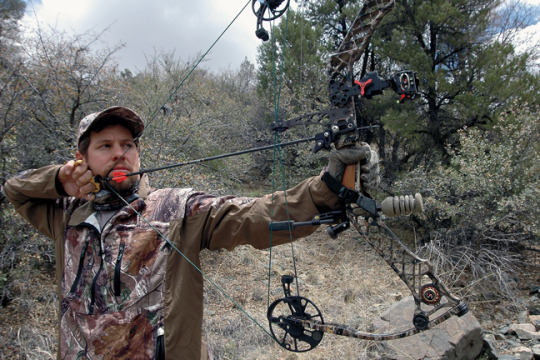
Now, the other elbow is important, too. Don’t draw them with a locked elbow, instead keep it slightly bent and rotated inwards, like the picture below.

Holding the Bow
Your character shouldn’t have a death grip on the bow. Instead, show it resting in the curve between the thumb and index finger. Here’s a wikihow article that describes the different ways to hold different types of bows that is more succinct than I could ever be. Ignore the crossbow (derogatory).
Anchor
Everyone needs an anchor. What’s an anchor, you ask? An anchor is a fixed spot that you draw your string back to whenever you’re going to shoot. It’s necessary in order to ensure consistency, which is accuracy’s best friend. Your anchor spot can vary. I anchor at the corner of my lip. Some people anchor underneath their chin. Some anchor to their ear. I’ve even seen some people in Asian disciplines anchor behind the ear or almost above the head, which is incredibly impressive. Bottom line, unless your character’s archery discipline has them draw behind the ear or above the head, you need to have them touching their head somewhere. The only wrong anchor is a short anchor. If you can’t draw the string back far enough to touch your face, that means you’re either trying to draw back a bow with too high a poundage, or the draw length is too short for you. The picture above of the person with the compound trigger release has a good anchor point on their face. The picture of the person with the arm guard has a good anchor point under their chin.
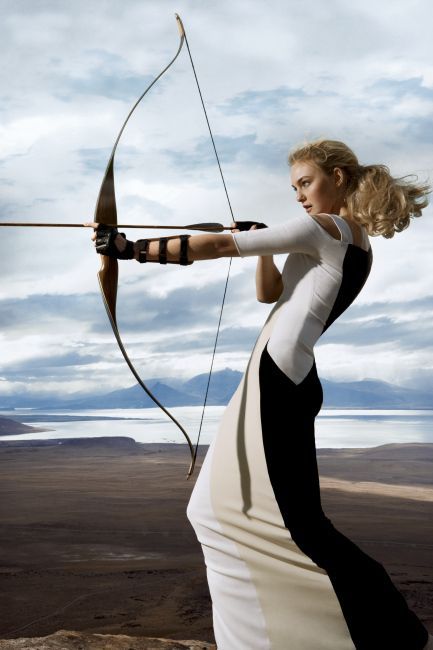
This person, on the other hand? Their anchor is out in space, that is to say they don’t have one (also their elbow discipline, posture, and stance are atrocious). I see this in fanart ALL THE TIME. It’s a pet peeve of mine. Don’t do this, have them anchor to their head or behind it somewhere.
Carrying The Bow
The best way is to just carry it in your hand by the bow (not the string). You can give your character a bow sling, or a back mount like Legolas has as well. You can slip the string over your shoulder and wear it across your back in a pinch, though this may damage the string. The only really wrong way to carry a bow is by the string, though you can damage your bow carrying it on your back if you’re stupid, and I’ve never tried to do so with a compound. Too pokey.
TL;DR
If you’re drawing a fantasy character, go buck wild. Still make sure to give them the right type of arrowhead, hand protection of some sort, a strong stance (no kneeling or sitting), good posture, a sensible draw, elbow discipline, an anchor point (don’t be like the person above!), and a good way to carry their bow, but you can have fun with the rest. If you’re drawing a character from history, research the archery discipline they would most likely use, and draw them with the appropriate bow type, quiver, arrows, protective equipment, stance, posture, draw, elbow discipline, anchor, and bow carry.
#archery#legolas#legolas greenleaf#lotr#tauriel#katniss everdeen#merida#green arrow#hawkeye#clint barton#robin hood#archer#bows#art reference#len speaks#holy FUCK it's complete!#i spent like five hours researching for this post jfc i'm beat#me: *sees one terrible piece of legolas fanart*#me: *cracks knuckles* tiME TO INFODUMP#anyways in conclusion fuck cr*ssbows uwu
1K notes
·
View notes
Note
Feel like tackling Kuroji? They sound like they'd be fun to analyze!
Another entry to the Shitodo siblings, maybe check out the general Shitodo post as well, since I'll skip over things I've already gone over there. That out of the way, let's get into it:

Ambiguously Paper-thin Archaeologist — Kuroji Shitodo
Name & Title
We've already gone over Kuroji's last name, Shitodo (鵐), in the general post. So I'll just make a brief mention that it is an archaic word used to refer to buntings (genus Emberiza).
Onto their given name, Kuroji (黒巫鳥), is read the same way as the word for the grey bunting (黒鵐 kuroji). In both, "kuro" (黒) means black, referring to the colour of the bunting.

In the character name Kuroji, JynX does something particularly strange: They assign one reading to two characters, 巫鳥 is read as a singular word "ji".
As discussed in the general Shitodo analysis, 巫鳥 is simply an older way to write 鵐, before it was combined into one character. JynX likely chose to separate it so that Kuroji's name wouldn't be 鵐黒鵐, and also to distance it from the direct word for the bird.
Kuroji's character title is "Ambiguously Paper-thin Archaeologist" (曖昧で紙一重な考古学者), while most terms here are direct, "paper-thin" is a bit more curious.
It comes from the phrase 紙一重, which refers to the "difference of the thickness of a piece of paper" and describes an extremely small difference between two things/concepts.
The phrase is perhaps most famously used in "there's a fine line between genius and insanity" (天才と狂人は紙一重) and other variations of it, usually in a negative sense. Although positive uses exist as well, commonly in sports commentaries, like in "close victory" (紙一重の勝利).
I'm honestly not entirely sure why Kuroji's title includes this part, it may be a jab at the fact that Kuroji is just slightly below Tsubakura, unable to make up for the paper-thin difference between the average genius and "the greatest prodigy in all of history".
A Genius the Shadow of a Prodigy
While the series' resident genius is Tsubakura Enraku, Kuroji is an impressive figure in their own right, apparently capable of doing "anything, to a certain extent".
So let's take a look at a few impressive feats Kuroji has achieved:
Unlike everyone else, Kuroji made their own danmaku toy instead of using the ones that Tsubakura made
They're a rather successful archaeologist and historian, primarily focused on prehistory
They've been a military strategist in the past, although they weren't fond of their time as one
They were likely the one to direct the siblings in building their log house when they first arrived in Mugenri
Kuroji: Front and Back
Kuroji plays pretty heavily into the series' overall themes of "front and back", that there are two sides to everything. Their obvious ability to "reverse front and back" aside, they seem to have a contrasting personality and thoughts as well.
Outwardly, they seem self-centered and condescending. Ambitious to a fault, they seem to take any chance they can get to improve their own situation, no matter the method. Even to the point where their own siblings describe them as a scoundrel.
However, it's also suggested that it may, at least, somewhat be an act. Mitori believes that they "are not a person who desires power purely for your own self-interests", while even Tsubakura says that they're "actually a pretty good person sometimes".
In addition, despite their haughty manner, they actually consider themself inferior to Tsubakura (even though they're oddly haughty about that as well), to the point where they've practically given up on outperforming them.
Now in Mugenri...
Curiously, wandering into Mugenri seems to have given them a new outlook on things.
Though we don't really get to look into Kuroji's heart that much, we do read a particularly surprising line to come from them in their Haze route ending in BPoHC, when they take the throne of the Dragonfly Castle.:
BPoHC: Scoundrel Haze Ending Kuroji "This is fine, isn't it…?" Aoji "What is…?" Kuroji "If I were to try and surpass Tsubakura…"
Here, Kuroji's usual (backhanded) humility is nowhere to be found, and they seem fully intent on rising above Tsubakura. It's quite the interesting change of heart, and until we learn more about them, we can only speculate as to what caused it, and how they think now.
And that's all you'll be able to get out of me, there's not much from a lore/inspiration perspective that we can really get out of Kuroji yet.
In my opinion, a lot of the intrigue with Kuroji so far lies in the way they act, their inner thoughts and personality. I'm not exactly the greatest at looking at this sort of stuff, and without much history or context to go on, I'm unable to say much more. In any case, I hope you enjoyed~
14 notes
·
View notes
Text
Discussing McLennon's opponents arguments
Disclaimer: By writing McLennon in the title of this post, I made a simplification. I understand "believing in McLennon" as believing, or even contemplating / leaving a window to the possibility that John and Paul's relationship was not purely platonic. This includes variations: that John was unhappily in love with Paul, that they were secret lovers, and - most likely in my opinion - that their feelings for each other were (at least in part) romantic, but they didn't do anything about it. Often, especially in general (non-Mclennon) Beatles groups, I am faced with disbelief or even outright dislike when someone starts this topic. Today I will try to look at what the opponents of our thesis say.
"You're just sexualizing everything! There may be a close friendship between men" (in a more ridiculous and nasty version that I saw in the comment on YT: "Only women and gays believe in McLennon because straight men know that there can be close friendship between men") Well, we start with a difficult topic. There are two different harmful points of view in society. The first is amatonormativity, according to which the only important relationship in a person's life is a romantic one, and friendships are less important. In this context, our critics might be right. BUT! There is also another harmful mechanism that must not be forgotten - homophobia. According to it, being an LGBTQ person is something wrong and a disgrace. Therefore, we cannot think of our idols (e.g., musical idols) as having (or contemplating) romantic and / or sexual relationships/feelings with people of the same sex. Homophobia permeates society as a whole, including historians who often interpreted two men who were close to each other as "just friends" (for example, Alexander the Great and Hephaestion). We are dealing with the same at McLennon. So we should be prudent and, where possible, fair when trying to judge any relationship considering the existence of both homophobia and amatonormativity.
"Who cares? What does it change if these two guys were in love?" Well, it changes a lot. If we accept that Lennon and McCartney were in love, we adopt a slightly different view of the breakup of the Beatles. That would explain (at least to some degree) why John was so ostentatious about his relationship with Yoko, why they got married just eight days after Paul, why he disliked Linda so much, and, most of all, why he attacked Paul so fiercely in 1970 and 1971. Of course, anger, jealousy, greed and insecurity can cause different behaviors (e.g. Gilmour and Waters fighting), but John and Paul fought each other like lovers. They wrote songs for themselves. In one of them, Paul, wanting to ease the battle, writes: "I'm in love with a friend of mine." Why? And why, for instance, does Lennon mention fucking McCartney in 1970s interviews? Broadening your horizon and accepting that the two guys had a romantic friendship would help with the analysis. Isn't that what being a historian/scholar is all about?
"It's impossible because they were both straight" This is something I wrote about above - plugging your ears and shouting: "Lalalala, my idol can't be gay!". Even if you don't think it is likely that two people had a non-platonic relationship, please be at least open to that eventuality. As for John not being straight - I'm preparing a masterpost on it, which will be released this month. Of course, I'll link it here later. As for Paul, the case is more difficult. I think I'll also make a post about it. I suspect (and would like to emphasize that this is only my interpretation, which may not be true) that Paul has been and is attracted to women all his life, and that the only man Paul has looked at romantically is John. It's like in this meme: "I'm straight but John Lennon is John Lennon" :D
"How can you discuss this? Isn't that interfering with their private lives?" Firstly: In my opinion, we can discuss the private life of celebrities, especially if they themselves decide to share it with us. John, Paul and those around them have largely decided to do so. Anyway, people have always analyzed the private life of the Beatels. Here, for example, we see a girl asking Paul in 1964 about his relationship with Jane Asher. And the most important thing: I've noticed that McLennon's opponents are quite okay with analyzing the private lives of the Beatles until the topic of homosexuality / bisexuality comes up. Only then do they say: "Leave them, it's their business!", not before. Do you know what it's called? Queerphobia. Secondly: Just read this post. That's all for now. What do you think? Feel free to comment.
49 notes
·
View notes
Text
History of Chinese standing collars (part 1: Ming & Qing)
So, a lot of people nowadays refer to a certain type of standing collar as a “Mandarin collar” but I'm not sure if that’s legit, because standing collars throughout Chinese history looked different. I was confronted by this topic when I was writing my post on 1950s Chinese fashion and felt like I had to make a separate post. I’m gonna do a quick break down of all the different types of standing collars in historical Chinese fashion from the 16th century to the present and how they developed.
Ming Dynasty (1368-1644)
The first mature 立领 liling standing collars were applied to women’s robes in the late 15th/early 16th century. Before any garment with a standing collar was invented, both men and women in Ming China wore garments with either a 圆领 yuanling round collar, 直领 zhiling parallel collar or 交领 jiaoling crossover collar, with crossover collars being the more common in womenswear.

Source here
Early Ming Dynasty portrait of a lady in a crossover collar robe.
The development of a standing collar was in large part thanks to the invention/adoption of the 子母扣 zimukou metal clasp button. I wonder why the fabric knotted buttons used on round collar robes were not used on standing collars in this period? They were awfully similar to the pankous of later. Anyway, at one point in the 15th century, some women thought it would be cool to add zimukou to their clothes and it resulted in this (they were also used on 比甲 bijia, 半臂 banbi and 短衫 duanshan but those are irrelevant to collars):
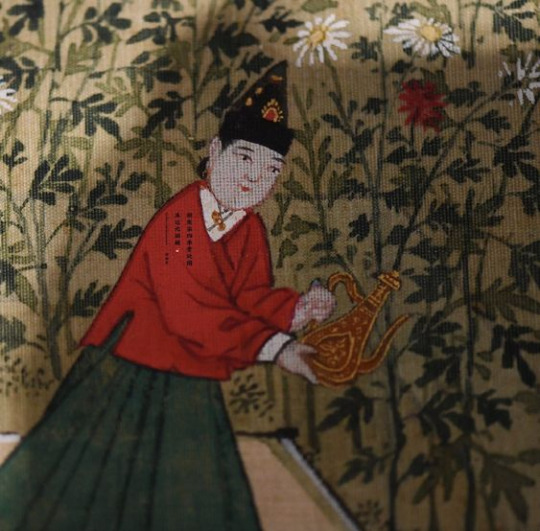
Source here
Part of 明宪宗元宵行乐图 (a painting depicting various Lantern Festival activities at the court of Emperor Xianzong), 1485. This lady is wearing a crossover collar robe with a zimukou at the middle.
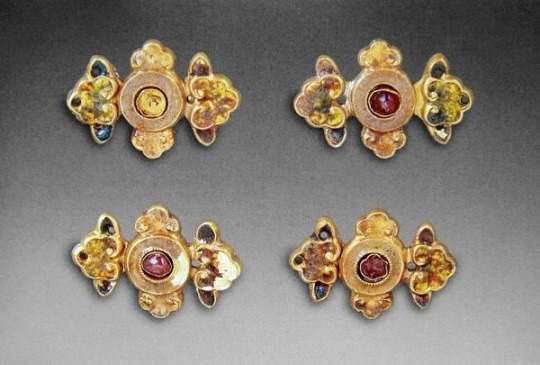
Source here
Modern reproduction zimukou. You could buy these for cheap on Taobao if you want to sew your own Ming style hanfu btw.
In the 16th century a fashion revolution took place in China: the standing collar, which came out of nowhere, began to suddenly dominate women’s clothing. This OG Chinese standing collar was very tall and form fitting, usually covering all of the wearer’s neck. It had sharp, rectangular edges and was closed by two zimukou, one placed at the bottom of the collar where it meets the bodice and another slightly above, not reaching the top of the collar. An important feature that set this apart from the collars of the 20th century is that it was unstiffened and made of the same fabric as the robe, meaning it was soft and could be worn with the top bit folded over, showing the lining which could be of a contrasting color. For archival purposes let’s call this collar style 1.
There are various theories as to why the standing collar was invented, e.g. because of colder climate during the little ice age, which peaked in the late 16th/early 17th century. Methinks it was just a fad which stayed.
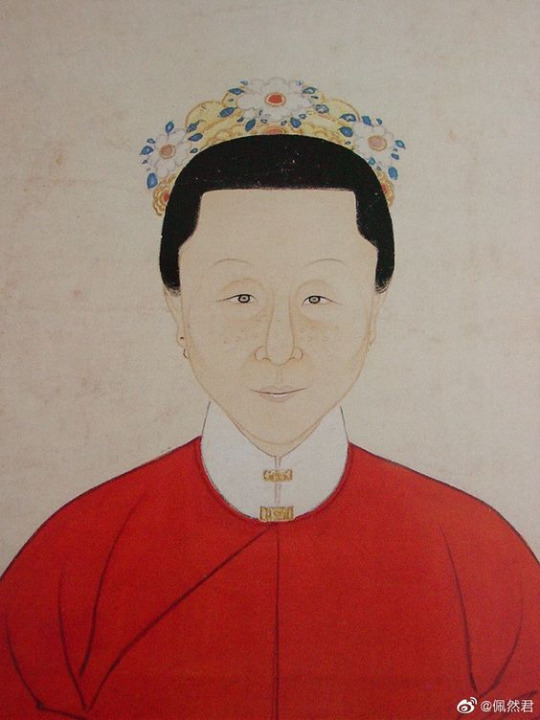
Source here
Late Ming Dynasty portrait, collar style 1.
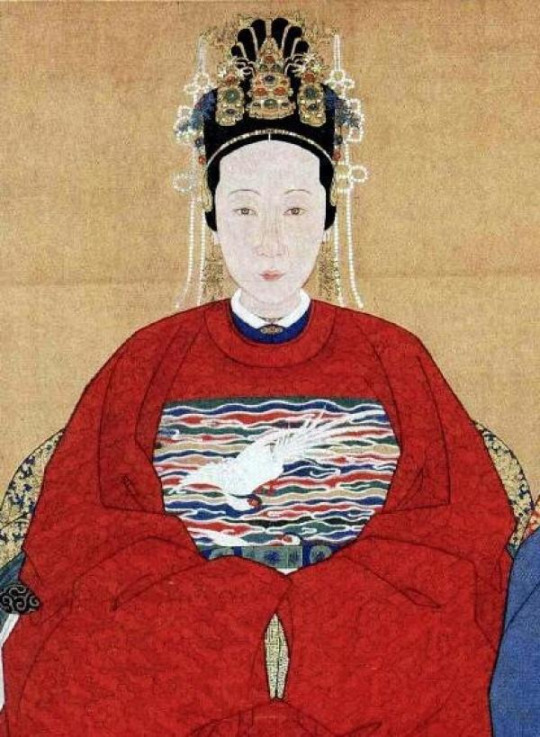
Source here
Late 16th century/early 17th century aristocratic lady wearing a standing collar robe underneath a round collar robe. The top of her collar is folded over. Collar style 1 variation 2.
Qing Dynasty (1644-1911)
This style of collar became the norm for Han Chinese women’s fashion in the mid to late 16th century and stayed that way throughout the 17th and 18th centuries. While the clothing silhouettes and accessories changed, the shape of the standing collar remained the same.

Source here
Late 17th century illustration for pornographic novel 肉蒲团 (1657). Collar style 1, but it became fashionable in the 17th century to have rows of piping around the neck for each button, so variation 3. Oh and wlw pride come throoouuuugh
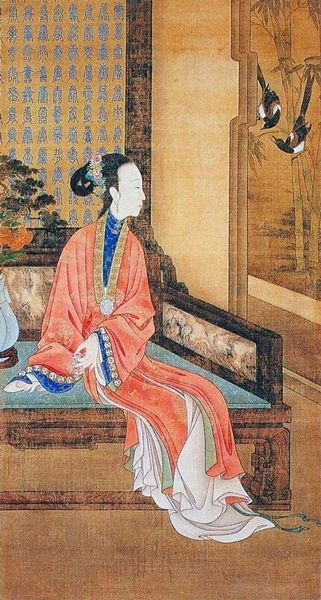
Source here
Early 18th century court painting, collar style 1 variation 3.
At some point in the late 18th century Han women decided it would be cool to use 盘扣 pankou, this fabric braided/knotted button of Manchu origin (more on Manchu dress later) on their collars instead of zimukou. The decoration also became more extravagant, with often rows of thick binding, piping or trim, corresponding to the decorations on the rest of the robe. It’s also slightly shorter, the upper button being at the very top of the collar. Let’s call this collar style 2.

Source here
(Presumably) late 18th century reverse glass painting showing collar style 2. The late 18th century deserves more attention, it’s such an important transitional period but also charming in its own way. This is true of European fashion of the period as well, I honestly love both places in the late 18th century.
In the beginning of the 19th century, the fashionable collar shape suddenly changed for some reason. It became extremely low, approximately only 1-2cm tall, only tall enough to accommodate one button. It still had crisp, rectangular edges. You could say this is another variation of collar style 2 but it is so iconic to the 19th century I think I’ll call this collar style 3.

Source here
Reverse glass painting ca. 1830. Han lady wearing a robe with collar style 3.
Now a brief look at Manchu womenswear. I am not an expert on Manchu historical fashion so tell me if I’m wrong. So the Manchus, who were apparently a confederation of Jurchen tribes from the area in what is northeastern China nowadays, invaded China successfully in the 1640s and remained the rulers of China until 1911 when they were replaced by the Republic of China. Throughout most of the Qing Dynasty Manchu women wore collarless robes, it was not until the mid 19th century that some Manchu women started to wear detachable collars to emulate Han women’s fashion, and not until around 1908 (!) when standing collars were actually added to their gowns themselves. Yes, period dramas did Manchu women dirty, poor gals have been dressed in the wrong costumes this, entire, time. The misrepresentation of Manchu historical fashion in the media in general is just fucking infuriating, but well, topic for a future post.

Source here
Late 17th century/early 18th century portrait of a Manchu lady. She is wearing a 衬衣 chenyi, a robe with straight sleeves, no slits and closed at the right side. It’s a casual gown worn for everyday activities. Her chenyi is collarless and the collar is closed by binding.
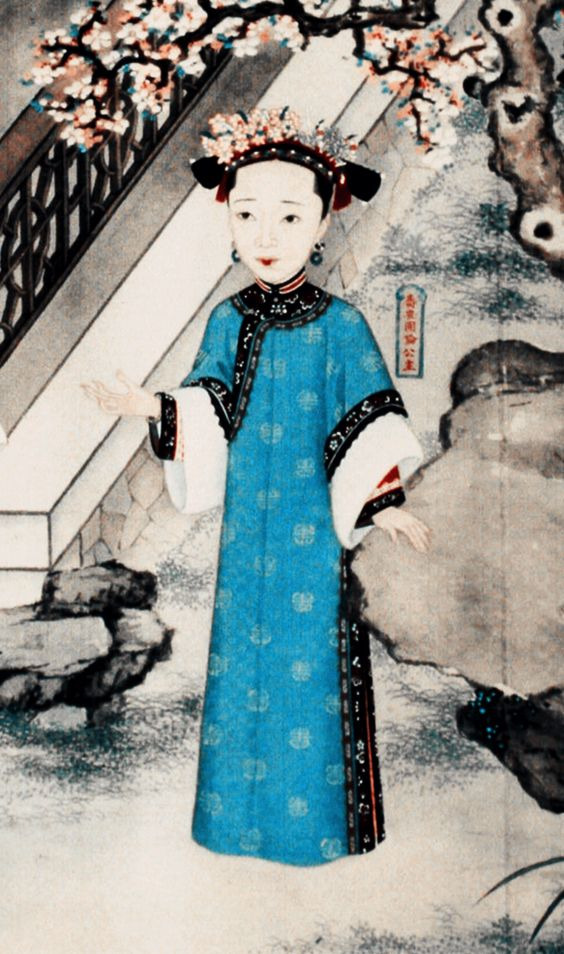
Source here
1840s/1850s court gown. She is wearing 氅衣 changyi (the bottom part of the first character should be 衣 not 毛 but this character is so obscure that it literally DOES NOT EXIST in the Chinese language anymore omg), a more elaborate style developed in the early 19th century with slits down both sides and wide trims along the collar, cuffs, side closure, side slits and hem. I have yet to see an extant example with a standing collar, all the changyi from the 19th century I’ve seen in museum collections are collarless, so the collar seen in paintings must’ve been detachable. Maybe some Manchu women liked Han women’s fashion and wanted to wear a detachable collar. I have, however, seen Manchu women’s vests and jackets with standing collars. These were similar to late 18th century Han women’s collars, so collar style 2.
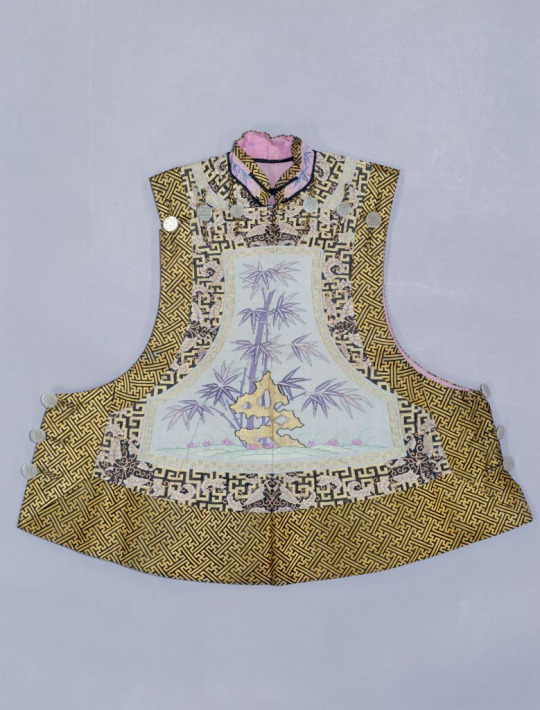
Source here
1890s/1900s women’s vest with collar style 2.
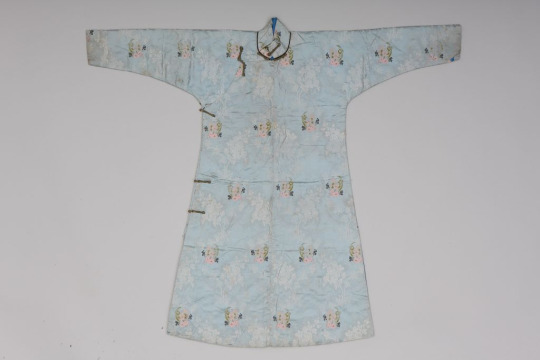
Source here
Ca. 1908. Chenyi with standing collar. If the passage of time is still not clear, notice the Western fabric used. Collar style 2.
At first glance this might look like a cheongsam but it is not. Chenyi did not have slits down the sides, unlike most 20th century cheongsam. It may have been a source of inspiration for cheongsam though, as I have explained in one of my 1930s posts, although the more obvious prototype for cheongsam was the changyi with slits and standing collars.
Let us now turn our attention to Manchu menswear, which is where things get complicated. In the 17th and 18th centuries, the Manchu riding habit, 行服袍 xingfupao, was a form fitting calf length robe with form fitting long sleeves and 马蹄袖 matixiu “horse hoof cuffs”, closed at the side with pankou. It was constructed in the same method as Han Chinese clothing. This original Manchu robe was collarless----I cannot stress this enough. The Manchus did not come barging into China wearing robes with standing collars goddamnit, get your facts right period dramas.

Source here
Portrait of Emperor Kangxi in a xingfupao. This is from the early 18th century already but the style didn’t change much so you get the idea. I love this color btw I think he looks great in it.
The xingfupao was an informal riding habit and only one small part in the gigantic system of Manchu court dress, the rules of which are well documented but I don’t bother to look them up. If you would like to do that, Google 大清会典. At one point in the early 18th century some Manchu dudes decided it was cool to add a collar to their xingfupao (like... Han women??) and it resulted in this:

Source here
An early example from the Kangxi era (1661-1722), a xingfupao with a standing collar of a contrasting color. The hem is detachable for horse riding (horse riding was an important aspect of Manchu culture and that influenced many of their fashion decisions). Judging by the fur lining I assume the standing collar was added for warmth in winter? I also saw some xingfupao with fur trim attached to standing collars so maybe that was the purpose.
Standing collars on xingfupao was constructed in a similar way to Han women’s collars, with rectangular edges and closed by two buttons. Pankous, which were unique to Manchu dress, were used instead of the Han zimukou. It appears that this collar was also soft and unstiffened, so it could be worn with the top bit folded over like in ye olde times (the 16th century). It’s important to note that xingfupao with a standing collar were not common at all, maybe a 1/20 probability to see in museum collections. Construction wise it’s similar to collar style 2 but it appeared earlier and was exclusive to menswear, so let’s call it collar style 4.

Source here
Qianlong era (1735-1796) portrait, xingfupao with standing collar of the same color folded over. Collar style 4 variation 2.
Another garment with a standing collar was the dress of the officials, known by white people as “Mandarins”. From the artworks and photographs I’ve seen, the collar only appeared in the outfit with a 行服褂 xingfugua, a button down tunic with straight, wide sleeves and slits at the front, back and sides. It was usually worn in combination with xingfupao, like how a shirt and vest are fixed combinations in European menswear. However, the collar of this kind of outfit was separate from the tunic itself. A plastron with an attached collar was worn underneath the robe and tunic (completely detachable collars were also used I think??) and the collar was buttoned from the inside. Not sure if this qualifies as a standing collar at all since it isn’t even attached to the robe itself, but anyway let’s just call this collar style 5.
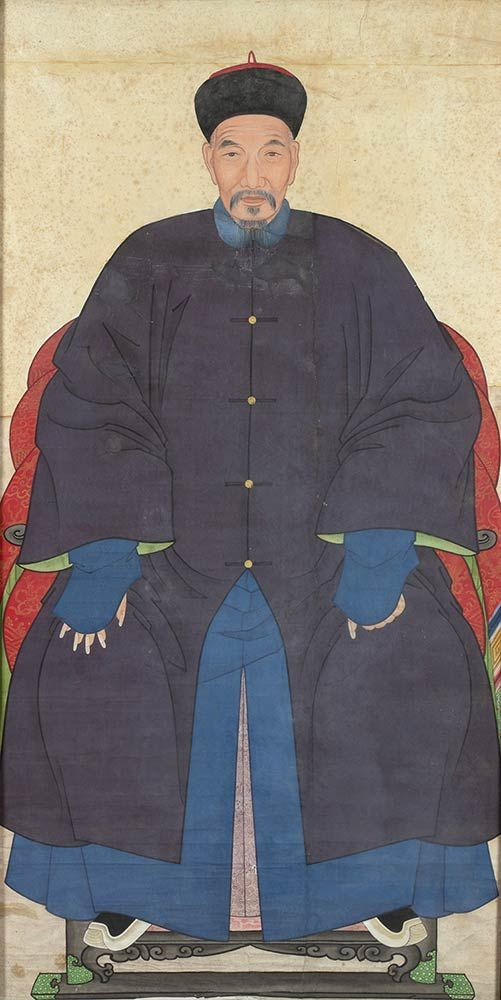
Source here
19th century portrait of an official. He is wearing a blue xingfupao, an indigo xingfugua and a blue detachable collar; a standard ensemble (well he’s also wearing pants and boots and stuff but that’s not the focus here). Collar style 5.
Oh I forgot to mention, after the Manchus took over China, they enforced their dress code on Han Chinese men but not Han Chinese women, so in the Qing Dynasty Han and Manchu menswear were one and the same but Han and Manchu womenswear were not.
I’ve only been talking about court dress so far, educated/well off civilian Han men would wear 长衫 changshan, a floor length robe, sometimes with a 马褂 magua, a short riding vest (derived from xingfugua), whereas poorer Han men would wear 短打 duanda, a short button down shirt, and pants. Well people who wore changshan also wore pants underneath but they’re not visible. All men wore pants tbh (incoming tangent), a while back when Harry Styles in a dress (which I stan) was making the rounds on social media some well meaning people were trying to find historical precedents for men wearing dresses and they named Chinese historical clothing as an example. I just wanna say, while I appreciate the sentiment, the harsh reality was that historical Han Chinese fashion was extremely gendered (except for a few brief time periods and a few select garments). Pants were reserved for men and skirts for women, the long gown like garments seen on men in historical portraiture were all robes, not dresses; you wouldn’t consider a long coat or bathrobe a dress nowadays, would you? Men always wore pants as undergarments while women wore petticoats. However I think that’s great for illustrating how our perception of whether a garment is masculine/feminine could change over time and that gender is socially constructed. Back to the main topic, to my knowledge, magua never had collars because it was a vest, changshan commonly had collars and duanda sometimes did too. I’m not sure when the standing collar began to appear on changshan, maybe when the court xingfupao gained collar style 4 it stuck in civilian fashion, maybe it was some point in the 19th century.
Anyway, fast forward to the late 19th century, the men’s changshan had a tall standing collar but again it was different to everything we’ve seen so far. It was exceptionally tall and had a smoothly tapering edge closed by only one pankou at the bottom. This resulted in a huge v shape gap down the middle. It’s still unstiffened but because of the lack of a rectangular edge it couldn’t be worn folded over. Let’s call this collar style 6.

Source here
Late 19th century/early 20th century portrait of a man. Changshan with collar style 6.
Let’s finish this part with Han women’s collars in the 1890s and 1900s. Around this time Han womenswear began to modernize and become simpler, but that trend did not apply to collars: the collars of Han women’s robes suddenly became unnaturally tall. They were so tall that they touched the wearer’s cheeks and couldn’t be closed at the front at all, kind of resembling Regency era European men’s collars?? This style of collar was oftentimes called 元宝领 yuanbaoling, ingot collar, or 马鞍领 ma’anling, saddle collar, after the object it resembles. Let’s call all of these tall collars that touch the wearer’s face collar style 7, but bear in mind these had a lot of variations.

Source here
Photograph from the 1900s. This could be categorized as a cursed variation of collar style 6 judging from how it only has one pankou and a tapering edge instead of a rectangular edge. But like, belle époque Chinese collars are a whole other species, so let’s comfortably call it collar style 7.

Source here
More collar style 7 representation. This collar style will never stop being funny to me, like just look at it it’s so tall.
So, in summary:
Collar style 1: OG Ming Dynasty standing collar, in fashion from the 16th to mid 18th century. Tall, unstiffened, rectangular edges. Closed with two zimukou. Could have piping (17th & early 18th century). Could be worn with top bit folded over (16th & early 17th century). Worn by Han women.
Collar style 2: developed from collar style 1, popularized in the late 18th century. Medium height, unstiffened, rectangular edges. Closed with two pankou/other fabric buttons. Commonly has binding, piping or trim. Worn by Han women in the late 18th century, partially adopted by Manchu women in the late 19th century.
Collar style 3: developed from collar style 2, exclusive to the 19th century. Extremely short, unstiffened, rectangular edges. Closed with one pankou. Commonly has binding, piping or trim. Worn by Han women.
Collar style 4: collar style 2 but simpler, appeared in the late 17th/early 18th century. Tall, unstiffened, rectangular edges. Closed with two pankou. Commonly plain. Worn by Manchu & Han men.
Collar style 5: detachable standing collar, a staple of official’s uniforms throughout the Qing Dynasty. Medium height, unstiffened, rectangular/rounded edges. Buttoned from the inside. Always plain. Worn by all officials (exclusively men in this era).
Collar style 6: civilian men’s collar characterized by v shape gap at the front, I don’t know when it first appeared, some point in the Qing Dynasty. Tall, unstiffened, rounded and dramatically tapering edges. Closed by one pankou. Worn by civilian Manchu & Han men.
Collar style 7: cursed belle époque (1890s & 1900s) women’s collars that touched the wearer’s face. Extremely tall, stiffened, both rounded and rectangular edges existed. Closed by one pankou at the bottom but sometimes had more pankou for ornamental purposes. Worn by Han women in this period.
Join me next time as we dive into the Republican era where things get extra complicated.
#hanfu#historic fashion#chinese fashion#chinese history#ming dynasty#qing dynasty#16th century#17th century#18th century#19th century
350 notes
·
View notes
Text
Generational Timeline
@cyber-phobia
So this isn’t directly related to the question “How did OfA survive as long as it did?” But I was working on it anyways, and the timeline of OfA is in there, and I’ve kind of been stalling on this, so I’m just going to submit this rough draft thing to you, and let everyone else worry about it
EDIT: This timeline is outdated! New version here.
~
Assumption 1: “Generation” as referred to in the phrase “X Generation Quirk” is in reference to “social” generations since the Dawn of Quirks, not how many generations quirks have been in an individual’s family
I’ll be using 25 year generations, because while I could use 30 year ones, the shorter generations make for a nice snug timeline, and I don’t want to do double the math to show both variations of the timeline at once
Inko is 4th generation (Chap. 1, pg 19) and 42 years old in canon (Character bio + birthday)
Izuku is 5th gen. and 16 in canon (bio + birthday)
Assumption 2: The kids in the Remedial chapters are supposed to be the start of the 6th gen (based on the fact that the Quirk Singularity first gets brought up by Mic and Meatball in 166, and basically everyone makes a point of bringing up how powerful their quirks are)
These kids are in primary school, and based off their appearance and the school’s name (translated “precocious brat”) I’d say they’re probably 6-7, 8 at the oldest. I will average this to 7, meaning that the current timeline is approximately 7 years past the start of the 6th generation, which gives us an almost exact timeframe (~132 years)
Now we can start working backwards.
Years ago / Years from the Dawn of Quirks
6 - less than 7 /132-126
5 - 7-32 / 125-101
4 - 33-57 / 100-76
3 - 58-82 / 75-51
2 - 83-107 / 50-26
1 - 108-132 / less than 25
Izuku was born 9 years before the end of Gen 5, or 16 years into it, meaning he’s a mid-5th gen child
Assumption 3: AfO was born during the first year of quirks
Daruma Ujiko is over 120 (Chap. 270, pg 3)
AfO would be in his 60s when he meets the doc in his 50s
I’d also like to point out just how convenient it is for AfO that Ujiko would just so happen to be rendered completely destitute and thus devote himself and his longevity quirk to AfO (chapter 270, 4) right around the time that he’s probably starting to worry about old age doing him in
AfO and OfA are both adults when OfA the quirk is created, so it was likely made approx 30 years after quirks, though I suspect for symbolic reasons it was ~32 years, so that OfA would be exactly 100 years old and that’s the reason it’s “reaching singularity” for Izuku
All Might Rising shows Nana died when AM was 18, then he leaves the country less than a year later
Before that Gran says All for One is OVER 100 years old, which means this is at maximum ~31 years ago, so All Might’s probably 48/49
Also, since he had OfA for ~30 of its 100 years, that means each of the previous holders would have had it for an average of 10 years
Assuming they all (except All Might and Izuku, of course) were adults when they got it, the approximate timeline for when they had it would be something like this:
First: ~100 years ago - ~90 years ago (had it in early-mid 2nd gen) (First generation quirk, obviously)
2nd: 90-80 (mid 2nd/early 3rd) (first generation quirk)
3rd: 80-70 (early-mid 3rd) (1st or 2nd gen quirk)
4th: 70-60 (mid-late 3rd) (2nd gen quirk)
Daigoro: 60-50 (early-mid 4th) (Black Whip, 2nd or 3rd gen quirk)
6th: 50 - 40 (mid 4th) (3rd gen quirk)
Nana: 40 - 30 (mid-late 4th) (Float, 3rd gen quirk)
AM: 30 - 1 year ago (early 5th-early/mid 6th) (4th gen, quirkless)
Izuku: 1 year ago to now (early/mid 6th) (5th gen, quirkless)
Off to another point
Kotaro was 32 some 15-20 years ago before he died (bio + math doesn’t work if he would have been 32 now) when Shigaraki was 5, and we know Tomura’s in his 20s now, which means Kotaro would be around the same age as, or slightly older than, All Might if he was alive
Which raises an interesting insight into his character. Since we know
A. Nana gave him up when he was younger,
B. He would have been around 18 when she died,
C. Nana probably had OfA around 10 years just like her predecessors,
We can get a timetable something like this: Nana gets OfA, AfO kills her husband shortly after, and she gives up Kotaro. Then she goes off to be a (public?) hero for A DECADE, eventually picking up Yagi because he’s around the same age Kotaro would be, before dying. From his perspective that would be around ten years of watching his mother be a hero and not coming back for him, and just as he’s reaching adulthood and maybe coming to terms with things, she dies in a way that almost certainly wasn’t publicized. (If the general public is mostly unaware of him save as an urban legend, there’s no way the government told people he killed her.) Which really puts his whole “Heroes hurt their families to save strangers” thing into perspective.
Now to a different thing,
The Meta Liberation Army had been in hiding “for generations” when ReDestro was a child, and since there’s no way he’s not in his 40’s bare minimum, (the man is balding for god’s sake, even in a high-stress environment there’s no way he’s the same age as Aizawa)(not to imply Aizawa is not in a high-stress environment) that means he’s 4th gen, and the only way things work out is if Destro was 1st gen and the Liberation War was during the 2nd gen. Which probably seems obvious without all the math, but that just helps confirm it’s not baseless.
~
Originally I was going to use this timeline as a backdrop to make a meta about the Quirk Singularity, but it kudzu’d, my focus is whack and you started making timeline posts and I wanted to throw my two cents in, so I’ll just summarize that:
A. The Quirk Singularity refers specifically to the increase in physical backlash from quirks over time, not just increasing power
B. Ujiko was correct that the earliest signs of it were visible in the fourth generation (Endeavor)
C. You can actually track the general trend of the singularity in the manga, based off characters’ ages (this was the part I still needed to get evidence for, but Aizawa’s dry-eye doesn’t seem anywhere near as severe as Shigaraki starting to disintegrate himself during Deika or Aoyama, and Recovery Girl and Gran Torino’s quirks both seem to not have any negative effect on them at all)
#bnha#mha#boku no hero academia#my hero academia#timeline#bnha meta#mha meta#manga spoilers#bnha spoilers#mha spoilers#bnha analysis#mha analysis
281 notes
·
View notes
Text
DEAR FISH FUCKERS, YOU’RE WELCOME
I’ve done what no other has done before (to my knowledge) and found the aging system for the Zora!
Ok so this started as simple research for this ask

See, I misread the phrasing of “best educated guess” to “research for 2 hours and come to a conclusive answer” so anyhow before I indulge you into the answers of the universe allow me to explain the research I’ve come across
[TL;DR at the bottom]
So firstly, we have to look at our conclusive evidence, from which we’ll base our theory/headcanon on, which can mainly be found in the Creating a Champion book, and some dialogue in game. I’ve compiled them all in these bullets here
Zora children are around 20ish years old [as said by dialogue with Finley in her love letter sidequest, I don’t have a screenshot but please just take my word for it]
150ish is considered middle-aged for Zora
Muzu is around 4 centuries old
Curved claws, weathered fins, and worn noses are signs of an older Zora that is more than 3 centuries(ish) old

Zora that were friends with Link must be around 150ish (not just 100), since you need to also account for the 20+ years of growing from a child stage, to the more normal sized form that you see them in the game, ergo, it’s that age plus the 100 years stasis that we determine the “middle age” of around 150

150 is the middle age, double that for the average old age of 300 years, but I say it could go to 400 too for additional reasons I’ll explain later with examples with my final age system. Anyhow, Muzu is around 400 if you take the 100 years for actually growing up from childhood, additional 100+ years of holding a different job as I doubt you just straight out hire a councilman without experience, and then another century for where he first started working in in the council, training Mipha, which would overlap with the period of the pre and post Great Calamity and Link’s return, meaning that’s 3 centuries plus 50ish years if we’re being generous with the overlap. This would help line up with the “for over a century” line as that doesn’t quite mean 2 centuries of working in the council, but Muzu is definitely getting up there to 4 centuries for his age alone
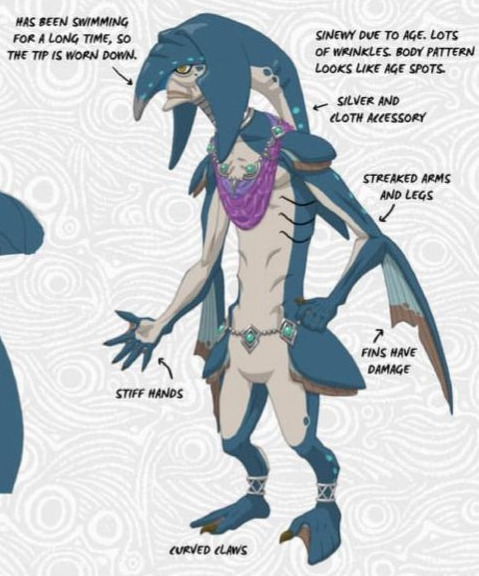
Now, I thought, this was gonna be my breakthrough, this screenshot here, depicting the traits of the older Zora. The elderly Zora are probably around 3 centuries old (since King Dorephan said they were young men around Mipha’s time, 150ish+100 gives us the range of 250-300), so I was like “Oh l can look at the size of their fins and noses and head/tail things and find a more efficient way to find their age” but nOPE. There is very little variation in that ballpark, the Zora either have exaggerated weathered noses or nice and shiny fins and no in between. The size of their head fins are roughly the same, with again, the only exaggerated differences being with the King and Sidon which doesn’t help at all because the Royal Zora already have a bunch of other difference such as their SIZE to name one.
I even went to the part about their curved toes, which initially would line up with some other Zora like Muzu

And let me tell you
I’ve looked at their toes
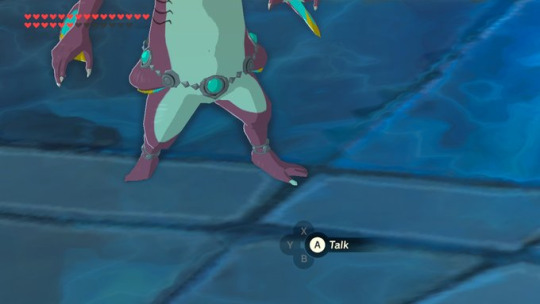
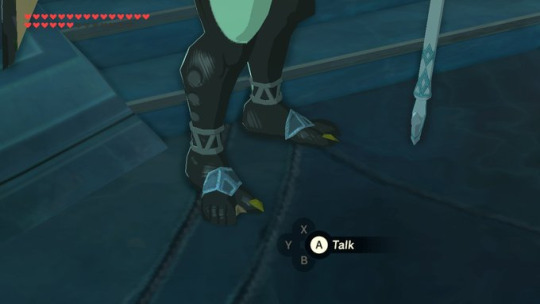

This is them from a child, a middle-aged, and an elderly. Color doesn’t matter and the curve? Well there’s
BARELY A DIFFERENCE
At least not nearly enough to find an efficient way to find age. Even Muzu’s final model didn’t have the exaggerated curvature as seen in the book.
I looked at their tail tail fins, (not the tail on their head, but their actual small rounded tail fin by their butts) because the book also mentioned how the grown Zora have more pronounced tail fins compared to the kids, but it was the same for the 150s and the 300s sooo not that helpful
So I kept digging. In the book I found that King Dorephan was crowned around 100 years before the game started. In addition I reread the 10 Zora stone monuments and found that he had killed a Guardian with his bare hands and thrown it off a cliff, which he still had a scar from.
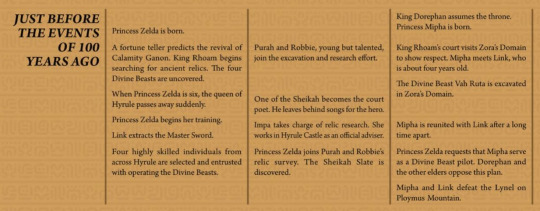
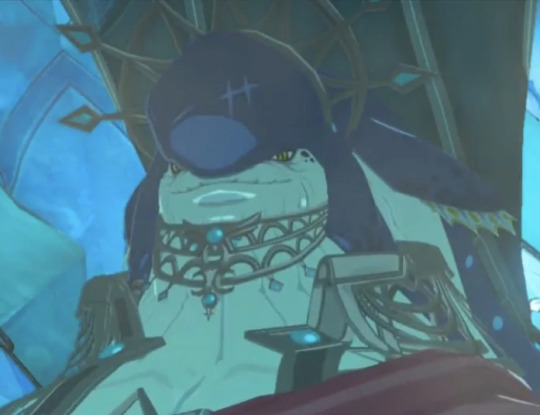
[and yes I attempted to find his definitive age by seeing how long it takes for a scar to fade but I gave up cause Zora anatomy is too different to find a conclusive answer]
So I was like, “ok Dorephan had to have been around 150 when he came to the throne, then 50 years later the guardians are excavated giving way to the story about the guardian...” blah blah blahbla I even went to the supposed site where that guardian was, but it all didn’t really give me that much more info than what I already knew. I was researching ways to age the rock monuments from visuals alone which needless to say is pretty impossible, so I gave up on finding Dorephan’s age and I kept digging.
All I wanted was something physical that could properly give way to identifying a Zora’s age was that too much to ask???
Now this is where I had all but given up, it seems that my only answer was this vague note about how their fins move up when they grow
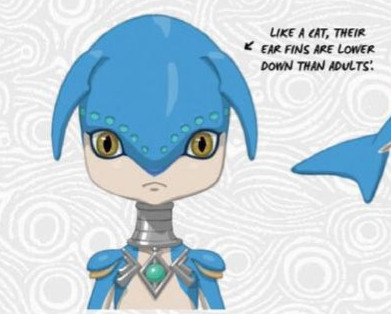
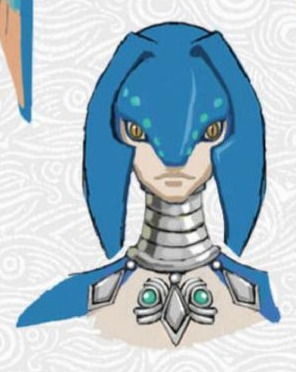
Which, to be fair, held true when I looked at the in-game character models myself, but I can’t exactly pixel measure these things for each Zora.
But THAT’S where the revelation came. I was so focused on finding inconsistencies within the elderly Zora, when I should have been looking at the young baby ones. See, this pictures, literally right next to the page about elderly Zora that I was analyzing for ages, is the key to it all

Now, I was thinking about the rings on a tree, and certain species of banded fish that grow and discard different markings as they grow older, I even counted the neck rings on certain Zora to see if they did that thing where they add a ring for each birthday like some African and Asian cultures do (look it up, that stuff’s pretty interesting!) and that is where it struck me.
Count how many luminescent markings are on their head
The males have 11, the females have 8 (on the one side, the other side has the same number of dots but for simplicity purposes I’m doing one side)
Now let’s count for these Zoras, who are middle aged-ish


The male has 10, the female has 7.
Now let’s look at the oldest Zora that we know of
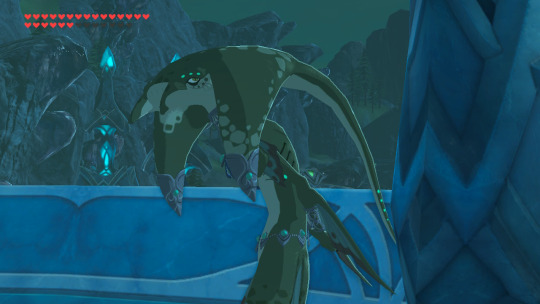
3 dots above the eye, four on the tail. Muzu that motherfucker has 7 damn dots and I couldn’t be happier.
MY DUDES, GALS, AND PALS THIS IS IT, I’VE CHECKED AND DOUBLE CHECKED WITH NEARLY EVERY ZORA I COULD AND THE NUMBER OF LUMINESCENT MARKINGS ON THEIR HEAD CORRESPONDS WITH THE AMOUNT OF CENTURIES THEY’VE LIVED, LITERALLY AND FIGURATIVELY DOWN TO THE DOT
First we have Muzu, who as I’ve preciously stated is around 4 centuries old. 11-4? Oh, it’s seven, and that’s the amount of markings he has? OOoo??
How about this Zora Lady who recognized Link from 100 years ago?
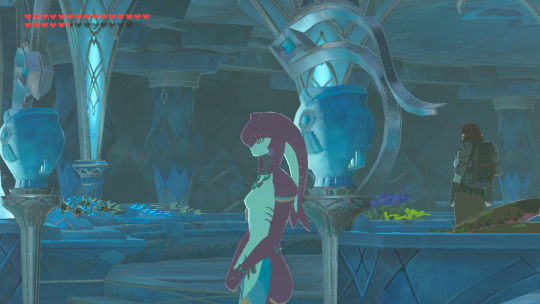
Seven dots? 8-7 is 1 so shes just over one century which lines up timeline wise. You can even see how the third dot is slowing shrinking on her head so she’s coming up on 2 centuries
Ok how about the elders?
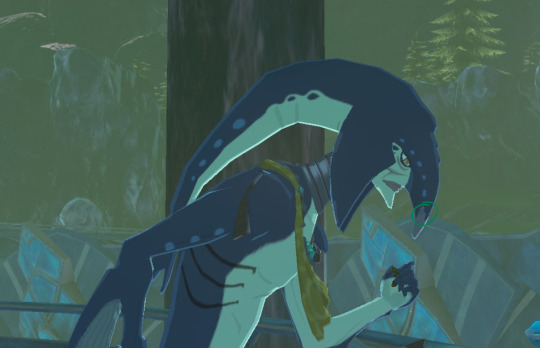
NINE. 11-9 is 2 centuries, with again, the dot by their head shrinking significantly showing how they’re getting up on 3 centuries.
The part I circled in green there is jewelry, not a marking, however this only goes further to prove my point. What better way to appear youthful than to have jewelry that makes it look like you have more markings than you have, made with luminous stone, no less.
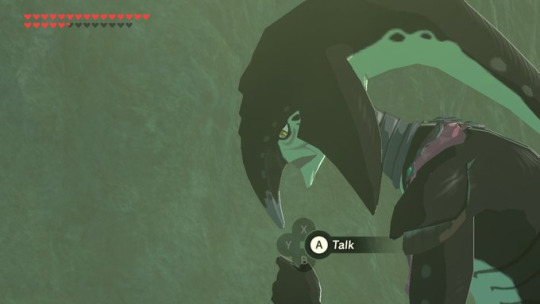
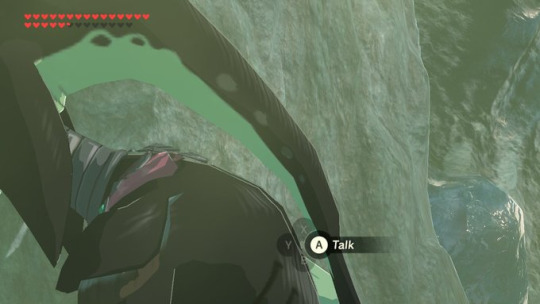
This guy? Seggin? Super close to 4 centuries, those dots are fading away fast. Count your days old timer
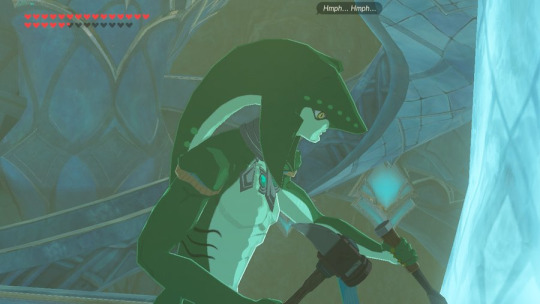
Random dude that doesn’t recognize Link but is an new apprentice for sculpture making? 10 dots, a fresh 1 century pal, lookin young
I was a feral child running across the Domain screaming people’s ages in their face like a rude, naive, brat, I was elated to say the least. Especially since this system even works on the King himself

[plus one dot slightly behind the fin here...]

King Dorephan has 7 dots, he’s 400 years old. Which still lines up timeline wise, especially since he’s similar age with Muzu who he has stated is one of his most trusted advisors, beecaaaaaaaause of the years they’ve spent working together the timelines match uppppppp
This system works for almost all Zora, with 2 exceptions. Guards have helmets that cover their markings, so it’s impossible to tell. In addition, Prince Sidon, has sixteen lights on this hammerhead because he’s fancy like that (we already know he’s canonically 2ish centuries old anyhow from the DLC)


EDIT: I WAS WRONG THIS WORKS FOR SIDON TOO. The sixteen markings I was referring to was actually the amount of marking on each side of the head total, however if we look at the markings for only one side, like intended
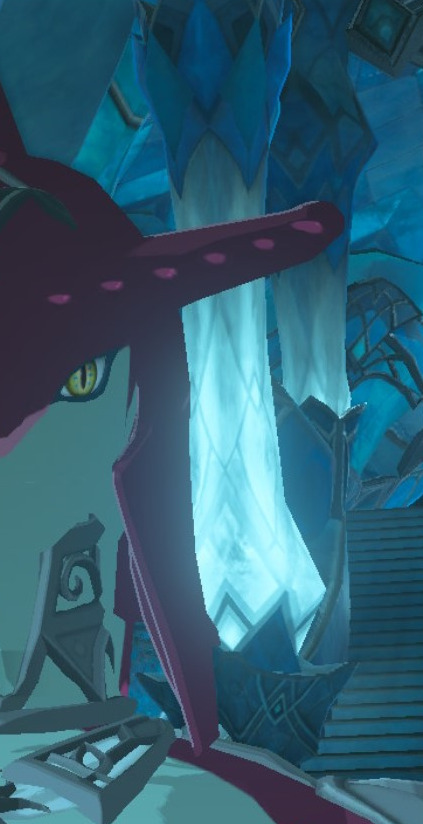

Ten dots, Sidon’s over 100 years old. I’d say he’s closer to 150 given the timeline
Essentially, the most surefire way to find almost any Zora’s age is to identify a male or female Zora, count the number of lights on the side of their head/tail thing, then subtract from 11 if they’re a male, and from 8 for a female. The number left is how many centuries they’ve lived. You can check to see if their markings are shrinking and fading to get a sense if they’re coming up on the next century anytime soon. Comparing this with the oldest Zora we see in game, we can conclusively say that the Zora lifespan is around 3 to 4 centuries since no Zora has been seen with less than seven markings
Now go and make your Zora ocs with your appropriate number of lights. I’m gonna have a cookie
#botw#breath of the wild#legend of zelda botw#loz botw#zora#zora botw#botw theory#botw headcanon#no fuck that this IS canon
1K notes
·
View notes
Text
Mudlark
aka. Chapter 46 of Where the Elfroot Grows (read on AO3)
---
Rhys Trevelyan - Fucking Herald of Andraste and newly appointed Lord Fucking Inquisitor - kneels on the warm ground of Skyhold’s garden, ripping out weeds with his bare hands, getting dirt all over his trousers, and trying his best to enjoy the autumn sun in peace. The walls of the garden are working as they should, collecting and trapping the heat of the day, even as the shadows cast by the trees begin to grow long. It’s brilliant engineering, even more brilliant than he thought at first. Even at lower elevations, the season for pears and applies should have passed, but the trees here are still producing. He suspects some sort of enchantment built into the walls to amplify the natural effects of the design, but he hasn’t been able to clear enough growth to uncover all the stonework. He’d have finished days ago. Except for Leliana and Cassandra interrupting his plans to declare him Inquisitor.
He’s as close to alone as he’s likely to manage anytime soon. Mother Giselle wandered into the chapel a half hour or so ago either to pray or to work on cleaning and repairing the ancient statue. She’d probably tell him that work and prayer are much the same if one has the right attitude of devotion to Andraste’s teachings and the Maker’s will. He heard the sound of other feet in the gallery a bit after Mother Giselle passed followed by the scraping of a chair being pulled into a desirable spot. Someone might be there still, but whoever it is, they aren’t bothering him, just trying to get a break of their own from the general cacophony of a hundred or so people trying to make Skyhold fully habitable.
It shouldn’t bother him so; it wasn’t as though he’d ever had space to himself in the Circle, but there’s something very different about being in charge of more than seedlings. And Inquisitor feels so much more permanent, so much heavier, than Herald.
Josie kidnapped him promptly after breakfast and trapped him in meetings all day. First with Leliana about the couriers she would be sending: to the Inquisition camps around Redcliffe, to the Chantry, to the College of Enchanters, to Queen Anora in Denerim, to Orzammar, maybe to the Queen of Antiva. Rhys had honestly lost count at a certain point, even though he did his best to read the ones she wanted him to sign. They were all variations on the same theme - an announcement that the Inquisition had survived the destruction of Haven, a reminder that they were responsible for closing the Breach, and requests for supports to oppose Corypheus.
Then, Rutherford and Cassandra wanted to discuss the soldier’s progress repairing an old road that ran through a pass between Ferelden and Orlais, just under the peak on which Skyhold sits. Rutherford says the road is in shockingly good condition and mostly only needs a bit of clearing a few holes filled to be usable by caravans. At the moment, the engineers can’t explain why it was abandoned, as once opened the route will save a significant amount of time transporting products between Orlais and the Lake Calenhad region. Further, they’d discovered auxiliary forts will secure Skyhold's control of what will be a valuable trade route. There’s some discussion of collecting tolls as a source of income for the Inquisition, but it all seems very abstract to him.
The only part of the report that Rhys is internally motivated to be interested in is the repair work on an ingenious winch and cable system that would allow people and goods to be moved up and down the mountain in a matter of hours, versus days. Like the road, it is in remarkable condition - a little grease and a few solders to the heavy cables made it functional again. They’re already able to use it to send messages and lightweight supplies up and down the mountain. (And one adventurous member of Bull’s Chargers. Rhys is slightly envious.) To operate it with any significant amounts of weight, they'll need some strong draft animals to turn the winches at the base and the summit, but Rhys is told that the contact he had made with the farmers around Redcliffe and a few generous handfuls of gold should be able to make that happen.
Rhys had just thought assisting the farmers to secure watchtowers so that they could better defend themselves seemed like the right thing to do as he had no solution to the conflict in the area. Even without Templars and Maleficarii, there were still bears to worry about. Rhys has developed a strong dislike of bears. But they do all the allies they can manage. And Rhys wouldn’t say no to a bear fur or ten or a hundred. Skyhold is magnificent, but with the exception of the garden suntrap, the temperatures are rapidly dropping below anything he’s ever experienced.
An hour after lunch, when he thought the four of them were finished with him, Harritt showed up talking about the tunnels underneath the keep that he’d been exploring with a small team. They go deep, far deeper than Harritt is comfortable taking the men without reinforcements, but he just feels that they reach the Deep Roads. Skyhold is close to Orzammar after all. No signs of Darkspawn, thank Andraste! But they do need to be mindful of the possibility of an attack from below. (It balances the threat of an attacking dragon from above, Rhys supposes. Good to keep your equations balanced.) Cassandra suggested that Harritt take Blackwall along with a few soldiers to explore further, and around yawns, Rhys agreed with her. If the road between Ferelden and Orlais is somehow valuable, why not a road to Orzammar? Or Minrathous? All the roads!
Rhys continues ripping out vines and mentally curses all four of them for promoting him from Herald to Inquisitor. (Although, he’s fairly sure that Rutherford isn’t entirely happy about having a mage in charge for the longue durée.) Morning glories - another plant that would generally need a warmer clime to survive, even as stubborn as it is. Pretty flowers, but they take over everything. He’ll transplant some to a bed near an arbor he discovered two days ago when he swung a machete at a stand of ragweed and hit a metal post. The morning glories will be a desirable replacement - Josie will like the decorative element - if he can keep them contained.
Why couldn’t Andraste just need a gardener?
That question, of course, assumed that Andraste is in fact, the Bride of the Maker and thus, endowed with the power to toss Rhys back out of the Fade (however he ended up there in the first place), which, in turn, assumes the existence of the Maker and not just an empty throne in the middle of a Golden City. And as far as Rhys has ever been able to tell, the Maker’s existence can be neither proven nor disproven, and the people debating it - quietly, of course - were both wasting their breath and risking their necks.
A better question might be, why in the Void did he let Cassie talk him into agreeing to lead the Inquisition? It was a bit unfair of her and Leliana to ambush him with the question in public. And Josie and Rutherford’s little display of rallying acclamation from the survivors of Haven strongly suggested that the decision had already been made before Cassandra and Leliana asked him.
From the Fade and into the fire. Just my luck.
Rhys is too distracted by humoring his own grumbling to notice the loose, mounded soil hiding under the vines until his right hand is buried well past his wrist and stinging sharply from hundreds of tiny mandibles pinching the flesh and sinking venom under the surface of his skin.
Rhys springs up and back with a yelp, flinging his arm to the side in an attempt to shake the ants free, then immediately back in front of him to cast a cage of lightning around the anthill, hoping that it circles deep enough underground to cut off the entire colony before any more of the ants can swarm out to attack him.
“Andraste’s flaming weasel -” Some of the ants have already gotten under his sleeve, and it doesn’t take many of this species to produce abject misery. He swats futilely at his arm, then gives up and tears off his jacket. “Knickerbocker tits!”
“Rhys, has some demon of dance possessed you?”
“Ants.” Rhys tosses the jacket aside and tries to crush the insects between the fabric of his sleeve and his arm for a second before ripping the buttons on his shirt open and stripping it off as well. A couple of the damned terrors have made it to his neck and chest. “Blighted fire ants.” Ugh. That’s a horrible notion - fire ants infected with the Blight. The Maker really will have abandoned us.
“So dramatic. Here -” Dorian attempts to brush a few of the blighters off before Rhys can stop him. “Fasta vass! That thing bit me.”
“Yes.” Rhys flicks one off his neck and sweeps his left hand over his right arm. Be damned nice if this Anchor were effective against fire ants. “Get me a bucket of water, will you?”
The static cage spell will wear off shortly, releasing any of the ants that hadn’t been shocked to death already. And those ants will be an infuriated horde with murder on their hive mind. Rhys ignores the stinging long enough to cast as controlled and intense of a fire spell as he can manage over the mound and watches with satisfaction as it erupts through the weeds and rolls over the anthill in a destructive wave. Invasive little fuckers. Kill them. Kill them with fire.
Rhys grabs the full bucket from Dorian and splashes the water over his right side, knocking most of the remaining ants loose and hopping away from that bit of ground before they can recover and decide to crawl up his leg.
“The hell are those things?”
“Fire ants.” Rhys glares at the scorched earth, watching for movements that might single a second assault. Dorian really must have spent the majority of his time in cities and libraries if he didn’t know about fire ants. The things are native to Tevinter and had been slowly invading the south for decades. He goes back to the well in the center of the garden and draws another bucket of water to dump over his head. “Also known as the most vicious little blighters known to Thedas.”
“Certainly they can’t be that bad. They’re just insects.”
“I fell into a mound once when I was still an apprentice... I’ll take a small horde of Darkspawn over these things.” Rhys rubs his hands over his neck and face. He doesn’t think he’s allergic; the bites should just be an irritant - just one more irritant for an irritating day - but people do develop allergies to insect bites following initial exposure. He can’t feel any swelling around his throat, but there is an itch along his jaw. He swats at his cheek - unsure if there’s an ant, or if he’s just imagining it - and inadvertently smears water and dirt together into mud.
“Ah, thus the warpaint.” Dorian smirks at him.
Rhys touches his face. The tacky mud over his cheek and nose sticks to his fingertips. Fortunately, it seems like Dorian is the only other person about to bear witness. Rhys laughs. Ah yes, he should definitely be in charge of a quasi-religious movement with a military. “Yes. The warpaint.” He slaps his thigh as he feels another series of stingings pricks. Excellent. One or two had made it to his legs, but at least it’s not a swarm. “And the two or three more fireballs I’m about to hit that mound with.”
“Such a vengeful little mudlark. Ready to defend his territory. Want help?”
“Oh yes. Fire. Kill them with fire.” Rhys casts another fire spell over the mound as the first burns out, silently apologizing to any innocent soil dwellers caught in it... But... Fire ants.
“Then quick healing spell, a bath, and clean clothes, I suppose?”
“Volunteering to help with that too?”
“I could be.” Dorian paces a tight circle around Rhys and flicks one of the insects off his back with a single manicured nail. “You seem rather distraught to be left alone.” A wave of magic - Dorian’s spells always feel warm - flows over him, easing the stinging, although the sensation - real or imagined or a combination - of insect feet has Rhys ready to crawl out of his skin - along with the rest of his clothes.
“Inquisitor?” Cassandra shouts down from a window in the tower she’s claimed for herself. “What are you doing? Why are there flames?”
“Fire ants!” Rhys yells back. That should be self-explanatory. He thinks the known range of the damned bugs includes Nevarra, but then Cassandra hasn’t spent that much time in Nevarra, and probably not that much time stomping through weeds anywhere. Andraste! Fire ants under armor. He shivers at the thought.
“What?” Cassandra sounds confused.
“Don’t worry about it, Seeker. The Herald and I have everything under control.”
Rhys can imagine her grumpy huff even if he can’t hear it over the sound of the shutters of the window slamming shut.
Dorian’s eyebrows arch high with amusement. “Be careful, Rhys, or there’ll be a rumor started that you’ve gone quite mad.”
“If I get many more bites -” He smacks a different spot on his thigh. “I just might.”
“Well then, we’d better go make sure you get them all drowned then. Is it safe to touch your shirt?”
“Leave it. Damn things will get confused now that their colony is gone and wander off in a bit.” He can retrieve the shirt and jacket to be cleaned later - once the ants are well gone. The morning glory vines around the ant mound are too green for the fire to spread easily, but Rhys throws another bucket of water over them to be safe. Josie would probably tell him it’s bad form to burn down one’s new base of operations. And then yet another bucket over his head.
If Varric has questions when Rhys, shirtless and still dripping water stalks past the table he’s writing at with an amused Dorian following behind, he keeps them to himself.
“Why so grumpy today?” Dorian asks. He’d volunteered to go find some dry, ant-free clothes for Rhys, and after returning to the kitchen storeroom - the most rational place to locate a tub for bathing until further repairs are made - had remained, leaning against the closed door and toying with the rings he wears, switching them from finger to finger. “You're normally as chipper as a little bird.”
“A mudlark?”
“Does that bother you? I won't call you that if it does.”
“No, no. I kind of like it.” Rhys scrubs a bit of soapy flannel between his toes - just in case an ant had found its way there. At least Josie won’t be able to complain about dirt under his fingernails for a few hours. “Much better than Herald.”
“Or Inquisitor?”
“Definitely better than Inquisitor.” Rhys slides down in the tub, dunking his head under the water again. His next oldest brother and little sister calling him snaggletooth when he was eight would be better than Inquisitor. Besides, he likes the way that Dorian says ‘mudlark’ when talking to him. Rhys resurfaces and pushes wet hair out of his face. “I really don't want to be called Inquisitor. And yet, here I am.”
“You know, the fact that you don't want to be Inquisitor might be precisely the reason why you should be.”
“I spent all morning trying to keep up with discussions on topics that I know nothing about. Politics, economics - roads! I’m not the right person for this.”
“You’ll learn. Quickly, I’m sure.”
“You’re more confident than I am.” Rhys flicks idly at the surface of the water. “But for what it’s worth, thanks.”
“Rhys, the kind of person who would be prepared for something like this is also the kind of person who is likely to abuse any power they are given. And you will have power once the rest of Thedas realizes the threat Corypheus poses. Wouldn’t you rather be the leader and not just the tool?”
Rhys lifts his left hand from the water and studies the Anchor carefully. Yes, a tool. An instrument that controls the Veil in terrifying ways that he doesn’t understand. Something that he’s not supposed to have and that an ancient monster desperately wants. The faint green glow is more apparent in the dim light of this basement room than it was in the sunlight of the garden - one more reason to cherish the place. “It feels so foreign. Wrong. Like some disease that should be pruned away.” He touches the first three fingers of his right hand to his palm and draws them slowly down to the fold of his elbow, following the path that the magic flows along before Solas pushes it back again.
Dorian’s brow creases and moves fluidly, kneeling on one knee beside the tub and catching Rhys’s hand in his. “You’ve managed well this far.” He weaves their fingers together, and almost - almost - touches his lips to Rhys’s knuckles. “You can always come rant to me, you know. If any given day is too much.”
Rhys remains still for the space of one, two, three heartbeats, then he runs his thumb over Dorian’s fingers, soft skin, metal rings warm with heat from his body.
Dorian’s eyes drop. His cheeks might be colored a touch, but Rhys can’t quite be sure in the dim light. He rises to his feet and turns away in a single elegant motion. “You should take a break. Soak for a while. Relax a bit.” He pushes the door open, just a crack, hesitating for the barest second. “I guess I’ll -”
“Dorian?”
His back straightens as he turns back around. “Yes.”
“Keep calling me mudlark.”
Dorian glances down, breaking eye contact between them, but the corners of his eyes crinkle as he smiles. “You know where to find me, Mudlark, trying to salvage books. I could try to do something about the mess you’ve made of your hands playing in the dirt again.”
#dragon age fanfiction#dorian x inquisitor#pavelyan#dorian pavus#dragon age inquistor#trevelyan#rhys trevelyan
11 notes
·
View notes
Text
Sephiroth’s true eye color (among other things)
Ever since I got into FF7 stuff I’ve wondered about Sephiroth’s rather inconsistent eye color over the media he’s appeared in (which is a lot), and I think I finally have an answer for it, as well as answers for other slightly unexplained phenomena. Warning you now, this will be fairly long and full of spoilers for multiple games in the series, yet hopefully informative.
Sephiroth is best known for his green, cat-pupiled eyes, among other things, and that’s generally the accepted eye color for him in fan works and such. But his eyes are actually light blue, and not just mainly in spinoffs. There will be a TL;DR in about the middle of the post for one interesting point, and another at the end for the whole post in general.
Disclaimer: This isn't intended to be a "this is the right way to portray Sephiroth's eye color" gatekeeping thing, this is just an analysis of an element of character design that went way too deep and is breaking Tumblr as we speak hfsdgyfudgfsd
Evidence, theories and such under cut-- all 63 images (yes, you heard me, be warned) either come from various wikis as official art/screenshots/etc. or are my own screenshots:
In Final Fantasy 7, where this mess all started, his iconic official art has green eyes:

But in all other art, models, etc. for the game, even the Ultimania scan, his eyes are light blue (or some sort of blue in general):

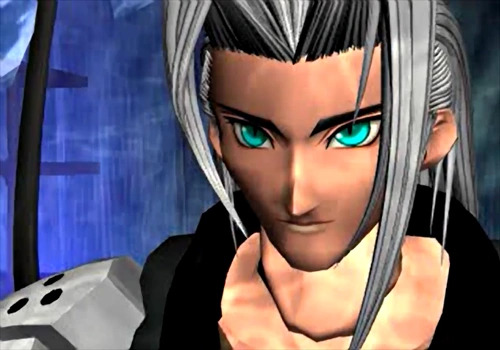
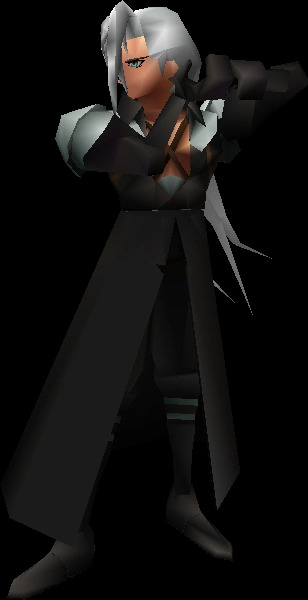
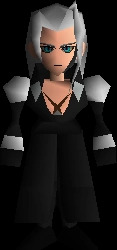
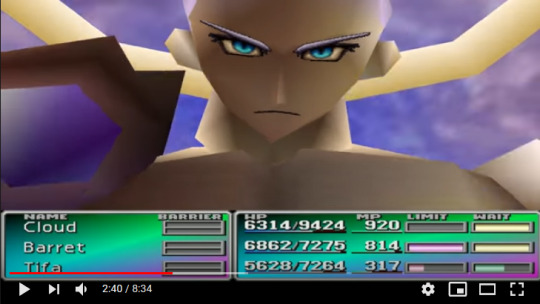
Of course, you could argue that Sephiroth’s official art also has blue eyes if you stare at it hard enough, but at first glance it’s more green than blue, and with the amount of green-eyed art I’ve seen, I’m sure many people have just accepted that his eyes are green and nothing more.
Several other games in the main series also portray Sephiroth’s eyes as light blue, sometimes borderline colorless depending on the lighting:
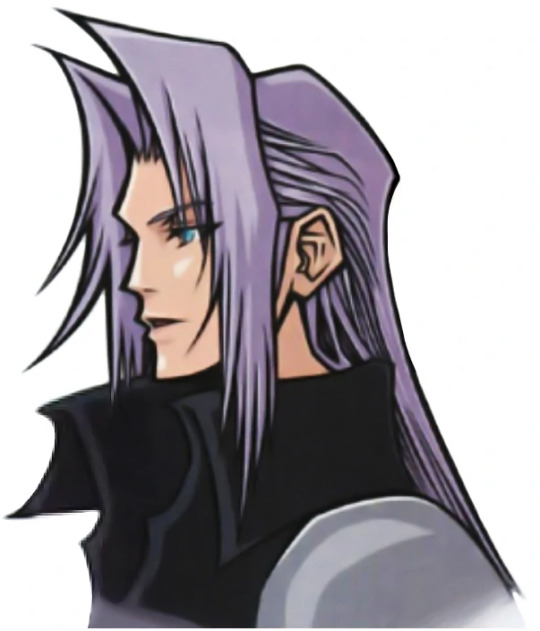
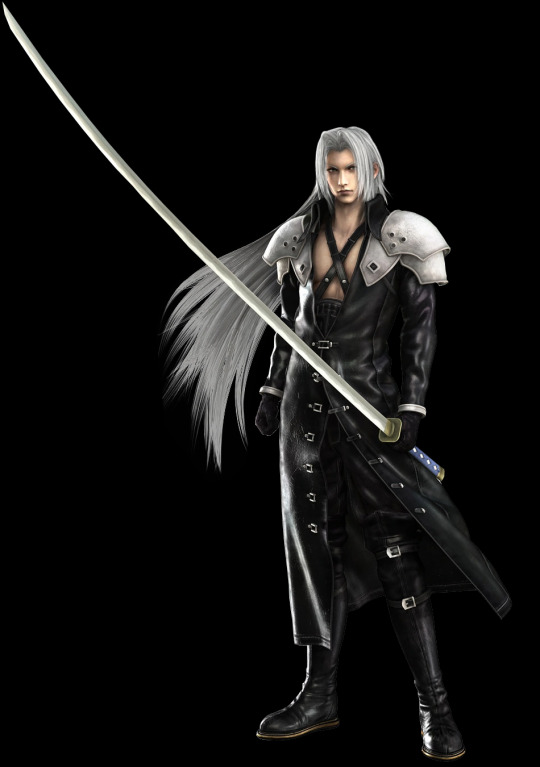
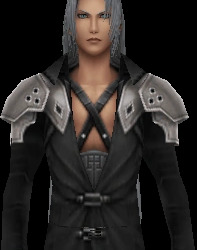
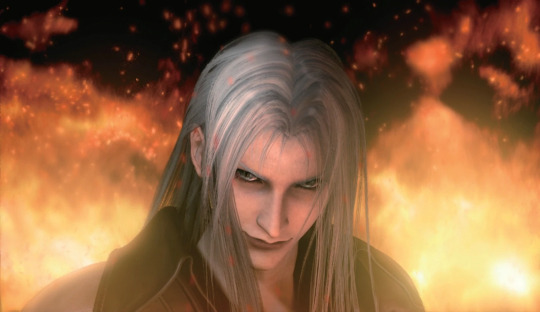
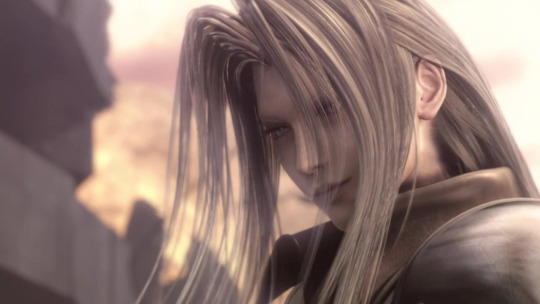
I particularly curse Advent Children for it’s washed-out aesthetic because in the darker scenes it completely masks Sephiroth’s real eye color. Thank the gods for HD screenshots.
However, there is a very interesting phenomenon that only seems to happen in Last Order, the 25-minute animated retelling of the Nibelheim Incident and Zack and Cloud’s escape 5 years after. No one seems to have noticed this yet, to my knowledge, so I’ll go through this as clearly as I can.
When Zack confronts Sephiroth in the reactor, the latter’s eyes are light blue:

It isn’t very obvious due to the mako glow tint and his face being in shadow, but I’d think green eyes would look different here, so they are light blue. They stay light blue for a while after this, until Zack begins to fight him and parries him onto the ceiling (anime physics...), resulting in this peculiar scene:
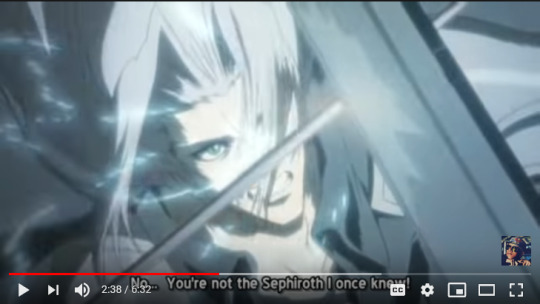

Light blue into green. Literally, you can see it happening in the actual video. This happens a second time when Sephiroth has Cloud skewed on Masamune, just more subtly:
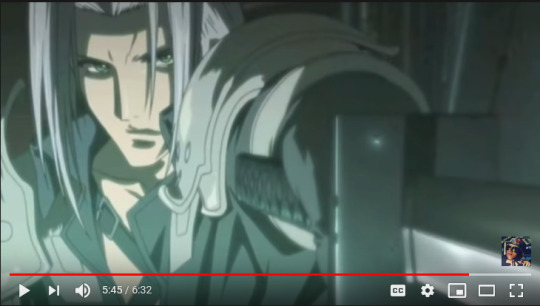
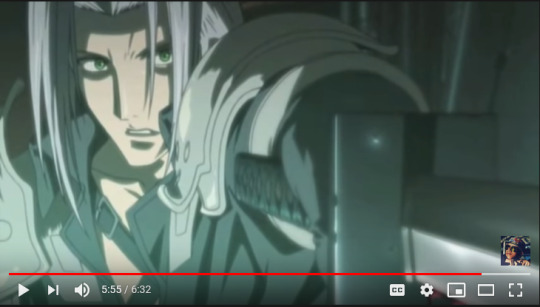
Again, light blue into green(er). Definitely something funky going on here. It goes back to light blue when Cloud tosses him away, though:

And speaking of Cloud... he, too, shows very obvious eye color change directly after this scene, as seen below:
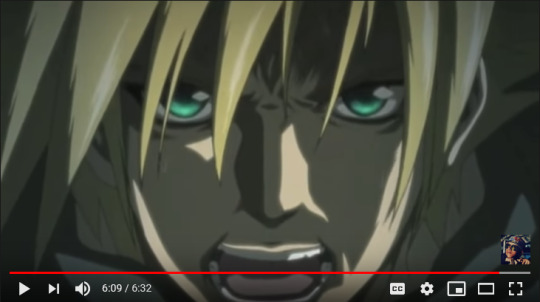
In the video they are visibly, animatedly glowing, it’s not just me discerning between two different flat shades of color. Keep in mind this is before he gets mako poisoned and Jenova-celled and whatnot, so this isn’t due to SOLDIER enhancements. What gives?
Here’s my take: it’s the Lifestream. People are made of Lifestream like everything else in in the FF7 universe, and it’s common knowledge that Lifestream/mako can do some pretty weird shenanigans. SOLDIERs are literally pumped full of the stuff and have seemingly superhuman abilities, and that’s just the lower-ranking ones. But the series has also placed a lot of emphasis on willpower, which Cloud post-experimentation struggles with due to the J-cells and stuff. A lot of people with particularly bright or “glowing” eyes have expressed an incredible amount of willpower, some of which include Cloud, Sephiroth (unsurprising), and Aerith:
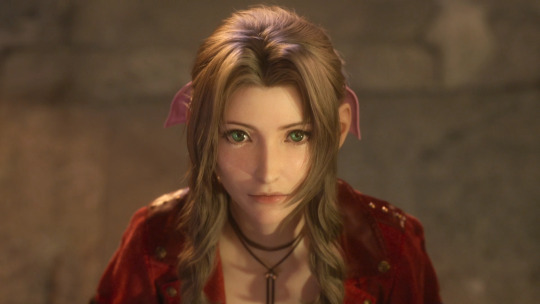
Aerith’s eyes have always been incredibly bright in the series, regardless of which game you reference. Remake especially makes this obvious, as it seems like every close-up shot of her makes her eyes the centerpiece regardless of lighting, setting, etc.:

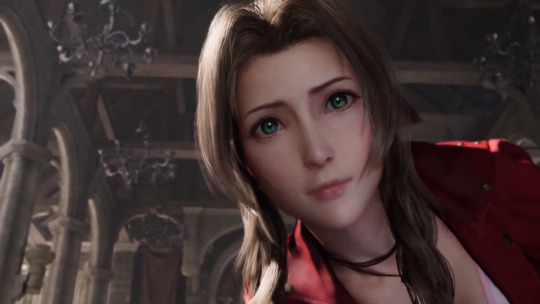
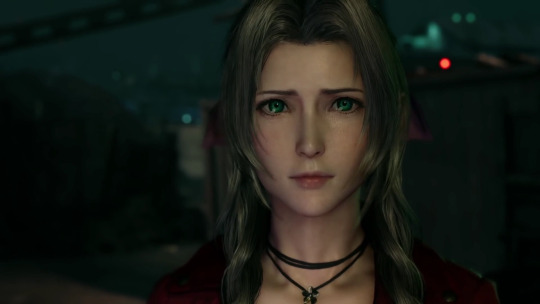
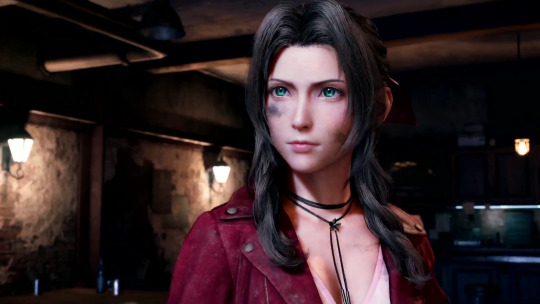
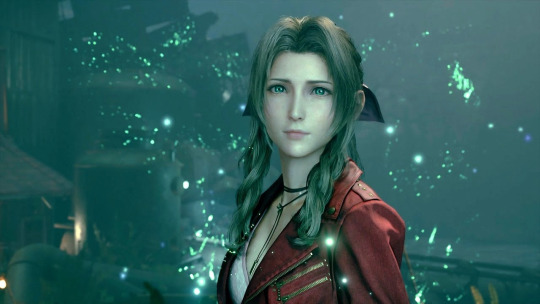
Like, seriously, they almost seem to glow they’re so bright. But here’s the kicker: Aerith is a Cetra, and the Cetra, obviously, communicate with the Planet... or, in other words, have an incredibly strong willpower that influences things. It’s been stated before by various people and media that Sephiroth and Aerith are two sides of the same coin, but not quite like this, I think. Cloud shows a similar phenomenon in his close-up shots as well, though the artificial SOLDIER glow is most likely contributing to most of it:
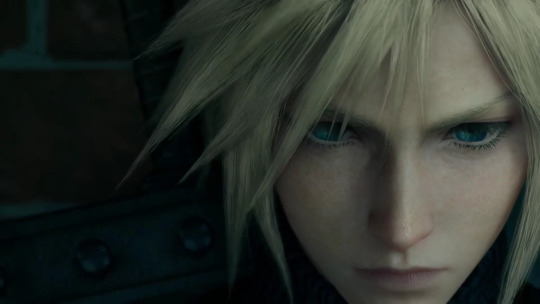
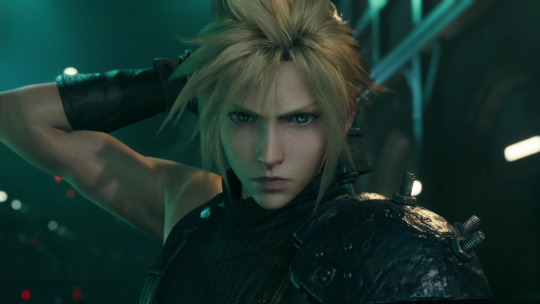
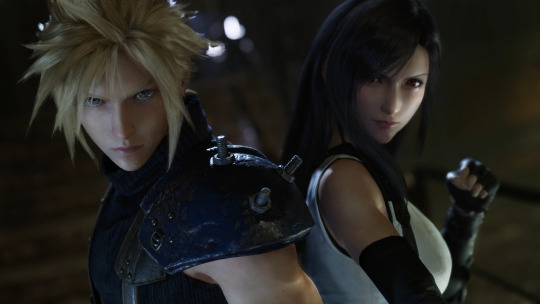


Compare these to younger Cloud in the Nibelheim flashback, when he was more innocent and had no need for incredible willpower, artificial or not:

Going back to Cloud in Last Order, the point we can make about him in particular is that when he was stabbed, literally at death’s door, he drew on his inner Lifestream for the strength to toss Sephiroth away. People have wondered for years about how this moment was even possible besides Protagonist Syndrome, and this may be the answer.
If this is the case, then this could apply to anyone: Aerith, Sephiroth, Zack, hell even Tifa seems to have slightly glowing eyes in the Remake sometimes-- and sure, it may be just the game engine making sure we can actually see their eyes in key cutscenes... but it ties into canon lore and actually makes sense, so I’m sticking with that. It’s also not a coincidence that Aerith specifically has green eyes, too, since the Lifestream in general is green-colored and whatnot.
Midpoint TL;DR: people with lots of inner willpower can call on their own Lifestream to give them strength, resulting in “glowing” or even color-changing eyes depending on how much Lifestream/mako they have in them. SOLDIERs, for example, would fall in the latter category... the most extreme being Sephiroth.
Now that's we're back at Sephiroth, another interesting point is that his eye color in Remake is consistently light blue, or some blue variation depending on the lighting, with green centers, as seen below:
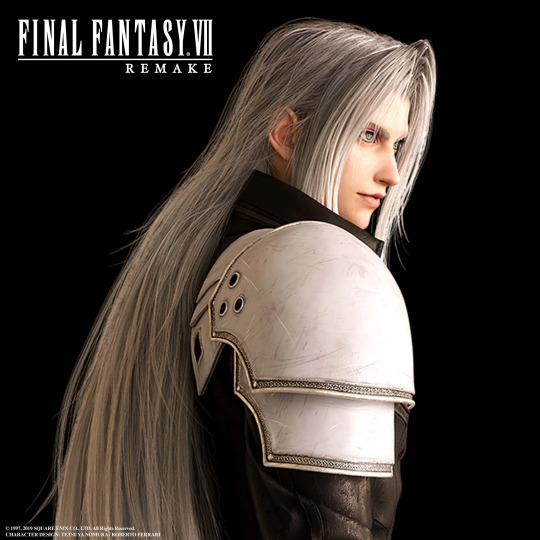
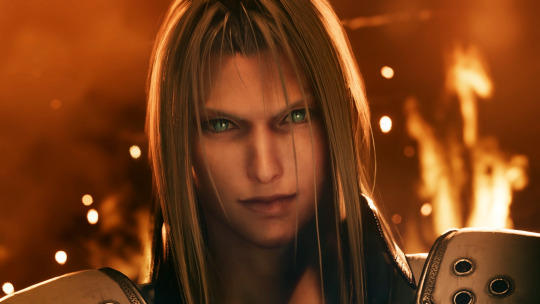
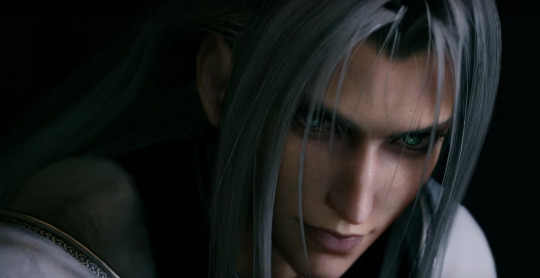
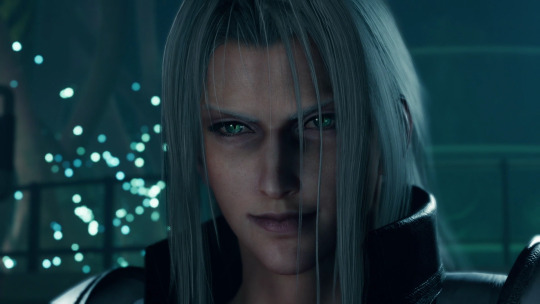
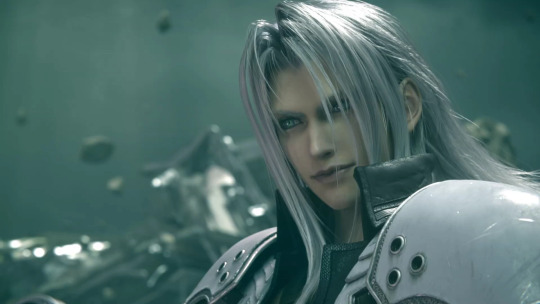

Cloud obviously shares the same eye color pattern by this point because it's implied that he has the same if not slightly more mako in him than Sephiroth, which very conveniently also equates to him having the same if not slightly more willpower than Sephiroth.
An honorable mention goes to the Remnants, since they, too, follow the light blue with green centers pattern, appearing to fluctuate between the two colors at certain times:
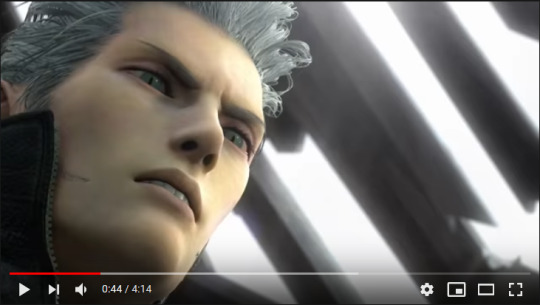
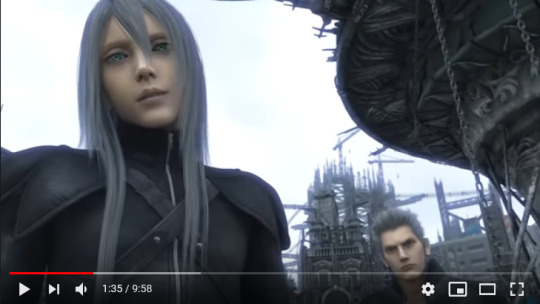

With all of that said and done, I’ll wrap this up by going through Sephiroth’s appearances in side games and other franchises as quickly as I can:
1) The Dissidia series (Dissidia, 012/Duodecim, NT, Opera Omnia) almost always portrays Sephiroth with light blue eyes in art, renders, and models, occasionally with a hint of green in them:
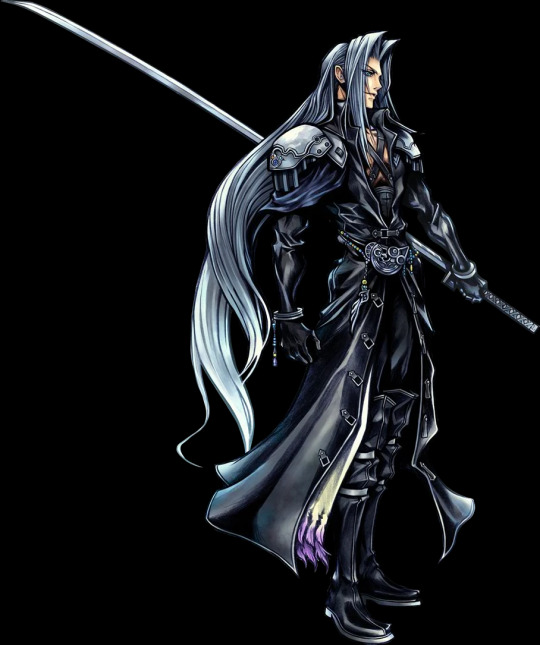
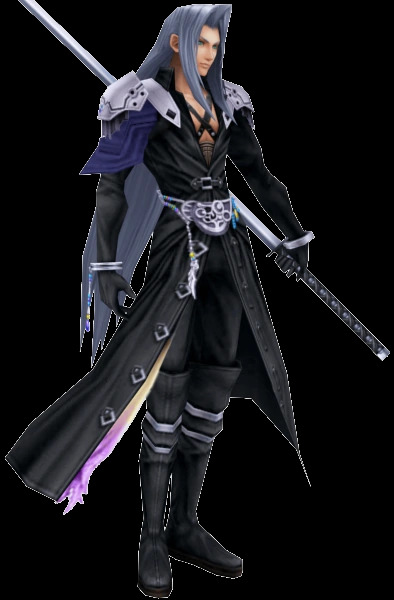


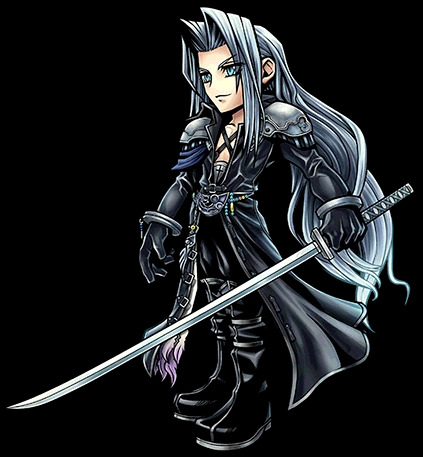

A very interesting exception is NT Sephiroth's Safer Sephiroth costume, which has completely white eyes in all three of its alts. Yes, it's basically just a cosmetic costume, but it's still worthy to note for comprehensive purposes:

2) World of Final Fantasy’s Sephiroth has light blue eyes:
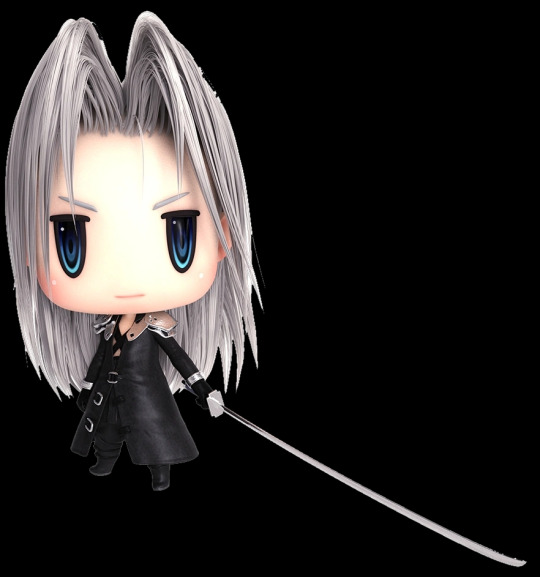
3) Record Keeper Sephiroth’s sprites are very obviously based on the original FF7 official art where he has green eyes (yes, I checked the colors by hand, they're all in the greener sections of the color wheel):


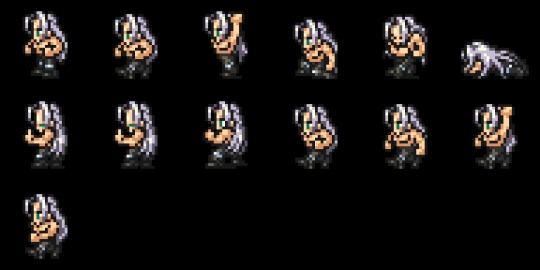
4) The Kingdom Hearts series is particularly unique because it features a blue-eyed Sephiroth but with an explicit reason for it. Kingdom Hearts 1 simply says that Sephiroth is part of Cloud’s past, but Kingdom Hearts 2 literally has Cloud saying “I'll get him. This time we settle it. Me, and the one who embodies all the darkness in me.”, and then explicitly clarifying that it’s Sephiroth he’s talking about. Sephiroth even shares Cloud’s facial shape, which is particularly obvious in KH2 renders:


All other Sephiroth appearances in the KH series also feature him with blue eyes, except for any usage of material from other media.
5) Itadaki Street games feature Sephiroth with green eyes:
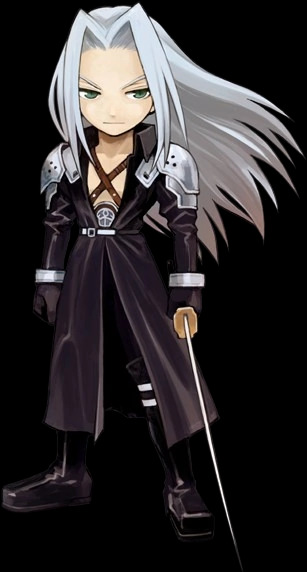

6) Puzzles and Dragons features a rare teal-eyed Sephiroth:
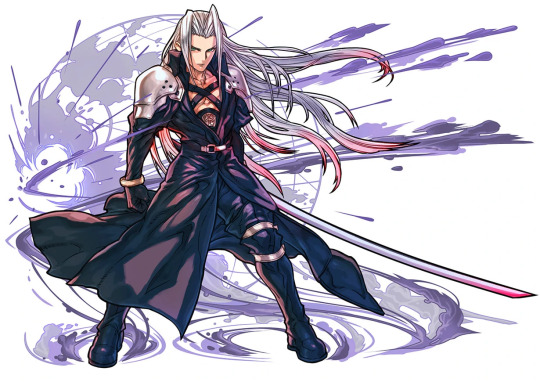
And finally 7) All other Sephiroth appearances in spinoffs and other media feature him with light blue, blue, or rare teal eyes, except for sprites, which are (most likely) reused from Record Keeper:
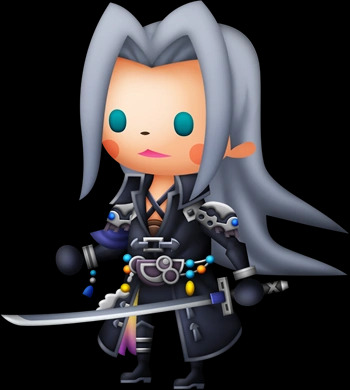


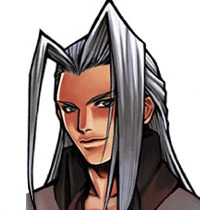
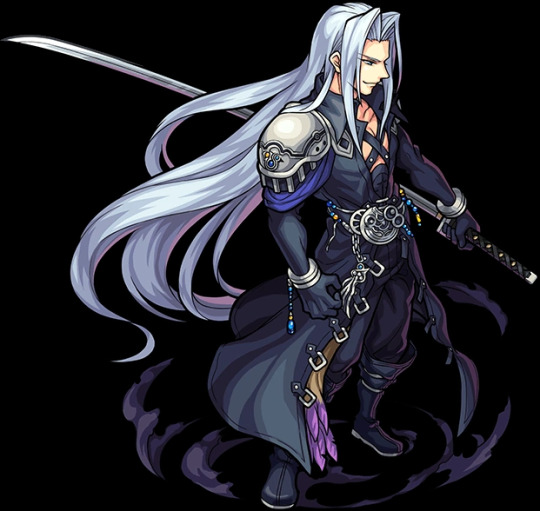
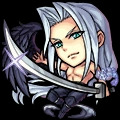
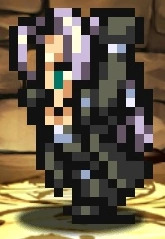
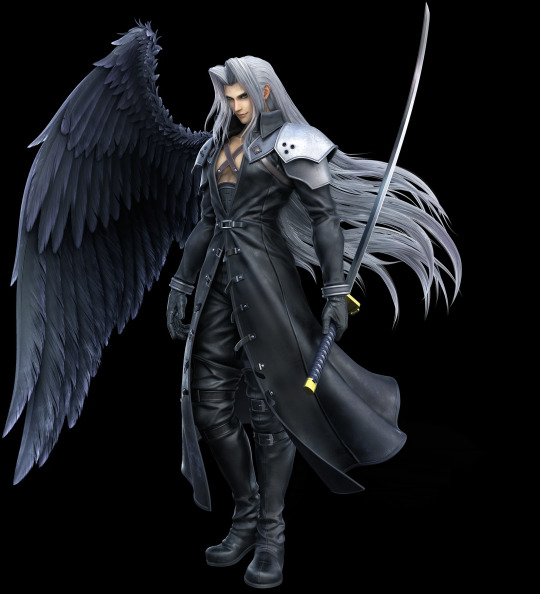
And that’s FINALLY a wrap. All my evidence for Sephiroth’s actual eye color in one place, and even a theory on why it can potentially fluctuate between that and the iconic green.
Actual TL;DR: Sephiroth’s eyes are actually light blue in 90% of his appearances, and the remaining 10% either comes from temporary green-ness or partial green-ness thanks to mako/Lifestream stuff, or spinoffs.
There is one small point I’d like to make at the end of this, and that is the remaining mystery of why Sephiroth’s pupils are even slitted and cat-like in the first place. That... is far more ambiguous in terms of evidence than the eye color. Some series, particularly the Kingdom Hearts series, have them as regular round pupils, while others sometimes if not most of the time give him the cat-like ones. I may make another in-depth analysis post trying to figure it all out, but for now I’ll say that it may just simply be a result of the Jenova cells he has or something along those lines.
If you made it this far down and didn’t just instantly scroll past my massive log of images and sundry, thank you so much for reading all of this! If you did just instantly scroll past, I don't blame you. I guess I'm in proper Sephiroth hell now, lol.
I hope you have a great day and that things turn out well for you fhjksdgfyhughuhyudfs
#final fantasy 7#ff7#if I tried to tag everything I mention in this post tumblr would probably die SO I'm only tagging the biggest and most relevant groups#final fantasy 7: advent children#last order: final fantasy 7#crisis core: final fantasy 7#before crisis: final fantasy 7#final fantasy 7 remake#dissidia final fantasy#world of final fantasy#final fantasy record keeper#kingdom hearts#itadaki street special#puzzles and dragons#sephiroth#cloud strife#aerith gainsborough#kadaj#yazoo#loz#sephiroth's eye colors#my text#can't believe how freaking LONG this is jfc#this is the most productive I've been in ages in terms of fandom
108 notes
·
View notes
Text
ok this took way longer than i expected because i got sidetracked looking at paintings and reading poetry and just admiring the mv, but it's finally finished!! let's talk about
higher
✨
i'm going to draw your attention to a few things.
firstly, these verses from rime of the ancient mariner by samuel taylor coleridge, published 1834:
The harbour-bay was clear as glass,
So smoothly it was strewn!
And on the bay the moonlight lay,
And the shadow of the Moon.
The rock shone bright, the kirk no less,
That stands above the rock:
The moonlight steeped in silentness
The steady weathercock.
And the bay was white with silent light,
Till rising from the same,
Full many shapes, that shadows were,
In crimson colours came.
A little distance from the prow
Those crimson shadows were:
I turned my eyes upon the deck—
Oh, Christ! what saw I there!
Each corse lay flat, lifeless and flat,
And, by the holy rood!
A man all light, a seraph-man,
On every corse there stood.
This seraph-band, each waved his hand:
It was a heavenly sight!
They stood as signals to the land,
Each one a lovely light;
This seraph-band, each waved his hand,
No voice did they impart—
No voice; but oh! the silence sank
Like music on my heart.
secondly, this ivan aivazovsky painting, chaos (the creation), c. 1841:
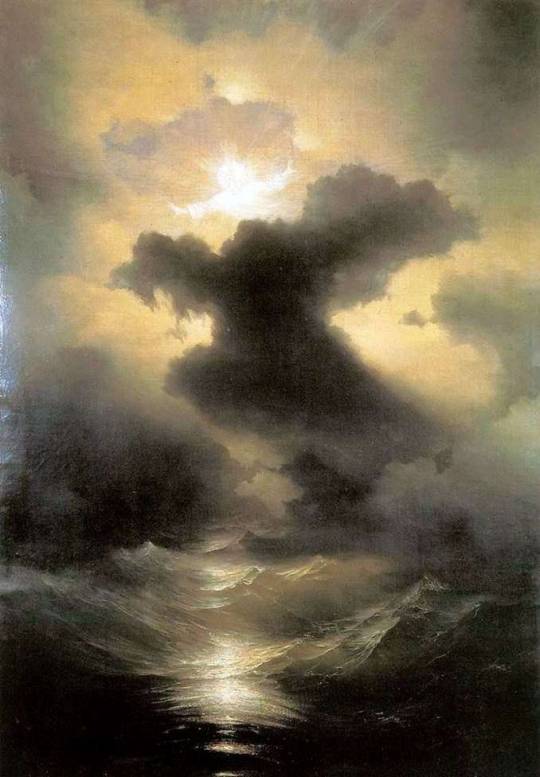
and thirdly, the memorial of percy shelley, who drowned in a boating accident at age 29, in 1822:
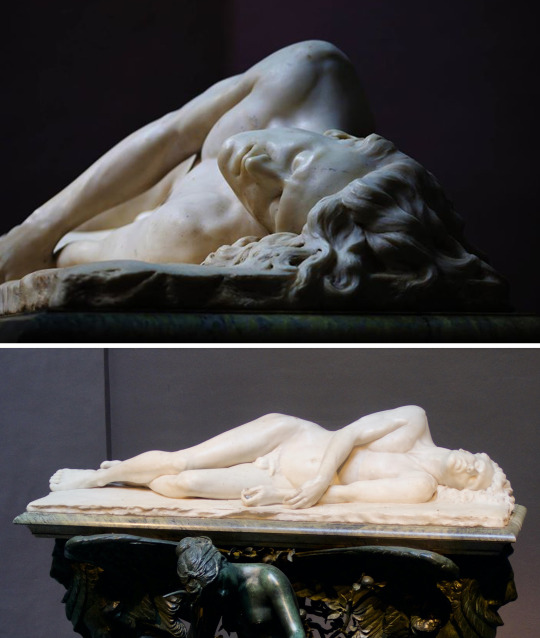
there's a common conflation between the romantic and the pastoral in the general cultural consensus because the pastoral a) has been around as an art term longer than romantic, and b) romanticism does use some similar imagery. but there is a key difference: the pastoral is specfically an idealization of 'the simple shepherding life,' often for high class and urban audiences who have no conception of the details of this life includes. one of the more famous examples is christopher marlowe's a passionate shepherd to his love, published in 1599:
Come live with me and be my love,
And we will all the pleasures prove,
That Valleys, groves, hills, and fields,
Woods, or steepy mountain yields.
And we will sit upon the Rocks,
Seeing the Shepherds feed their flocks,
By shallow Rivers to whose falls
Melodious birds sing Madrigals.
And I will make thee beds of Roses
And a thousand fragrant posies,
A cap of flowers, and a kirtle
Embroidered all with leaves of Myrtle;
A gown made of the finest wool
Which from our pretty Lambs we pull;
Fair lined slippers for the cold,
With buckles of the purest gold;
A belt of straw and Ivy buds,
With Coral clasps and Amber studs:
And if these pleasures may thee move,
Come live with me, and be my love.
The Shepherds’ Swains shall dance and sing
For thy delight each May-morning:
If these delights thy mind may move,
Then live with me, and be my love.
whereas romanticism is a more pointedly specific movement that was active from around 1800 to 1850, primarily focused on intense emotion and catharsis as the primary experiential output of an artwork. which most prominently manifested in a deep fascination and glorification of the natural environment and historical nostalgia. the movement sprung from the german sturm und drang (literally storm and drive/stress) period of the late 1760s to early 1780s, which was a direct reaction to rationalism and enlightenment. romanticism had similar impulses; it was also a revival of medievalism and a reaction against the looming urban sprawl and mechanization of the industrial revolution. a typical romantic poem from one of the originators of the english movment william wordsworth, composed upon westminster bridge, september 3, 1802, originally published 1807:
Earth has not any thing to show more fair:
Dull would he be of soul who could pass by
A sight so touching in its majesty:
This City now doth, like a garment, wear
The beauty of the morning; silent, bare,
Ships, towers, domes, theatres, and temples lie
Open unto the fields, and to the sky;
All bright and glittering in the smokeless air.
Never did sun more beautifully steep
In his first splendour, valley, rock, or hill;
Ne'er saw I, never felt, a calm so deep!
The river glideth at his own sweet will:
Dear God! the very houses seem asleep;
And all that mighty heart is lying still!
this romantic fascination with nature was underpinned by the philosophy of the sublime, generally agreed to be first treatised by edmund burke in 1756, the theory was also written about by kant and hegel. in the simplest of terms, the sublime is a quality of greatness beyond calculation, imitation, and human comprehension. the sublime is twofold; the greatness of the ocean is beautiful, but its power is also terrifying, and the experience of the sublime is to feel those two at once. to be in awe and also to be horrified of its ability to sink ships and drown a life in a tempermental change of tide.
let's take a quick detour to talk about
clothing
in the present day we have become much more lax thanks to the aesthetic movement in the late nineteenth century, but back in the early victorian period there are still highly structured rules about when and what clothing one can wear in public. and the clothing itself is also highly structured. anyone with a passing understanding of the victorian era knows about the whole flashing of the ankle thing and corsets galore, and it is true that the general day to day garments cover a lot of area. for men in particular, this manifests in no less than three layers in public at all times: shirt, waistcoat, and suit jacket, with a coat or mantle overtop in colder temperatures. this also includes a variation of a neck tie (depending on what year), hat, gloves, and any other decided upon accessories (this can also include a corset and other padded structural underpinnings). an important tangent to mention here is that this is the uniform of the upper classes, although the rules do apply to the lower classes if they wanted to appear 'sophisticated.' the working man's uniform was also shirt, waistcoat, trousers, but the difference here is in the textiles themselves; the colours tended to be much more drab, with less complicated patterns. obviously due to the price fabric itself, but also due to the labour of laundry. an indicator of class here is the white shirt itself and its pristine implications. (there is a longer conversation here about the invention of neckties and detachable collars and cuffs, but that's for another day). the silhouettes are very important to note here in the higher mv, as they are directly referential to the 'romantic poet' archetype of loose shirt and tight pants that we see in popular culture. but as i've just said, the reality is that men of the era were not dressed like this out in public. this look is essentially underwear; the implications are salacious. so where did this come from? well, we can blame it mostly on lord byron, who by all accounts was the first western 'rockstar.' notoriously called 'mad, bad and dangerous to know' by lady caroline lamb (a married women he publically had an affair with), byron was openly bisexual and deeply hedonistic with a lot of questionable habits, but his poetry was so popular that he was known to have women following him in the street and gathering in large quanities to see him at salons. and this was close to three decades before lizstomania. his close friends and contemporaries included percy and mary shelley, with whom he lived with abroad in italy for some time (this living arrangement resulted in the writing of both frankenstein and john polidori's the vampyre). byron's reputation was so eclipsing that the image of the lush poet lazing in his undergarments has become its own genre of romantic, slightly removed from the movement byron was writing in. it's also worth it to point out that there are no official portraits of byron dressed like this from the time. the visual assumption is somewhat apochryphal. now let's get into some specifics. a.c.e is not unfamiliar to this silhouette; as previously mentioned in this post i wrote about their styling, the boxy loose upper and fitted lower is their general mode for their styling because of its emphasis on legs. cactus was the most extreme example of this, and to prove my point, this specific silhouette is extremely common in classical ballet:
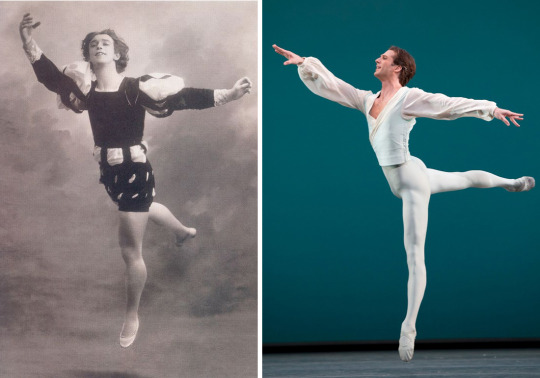
1. vaslav nijinsky, giselle, 1911 2. nehemiah kish, george balanchine's ballo della regina, 2011/12
higher fits very neatly into this same category: we have an emphasis on the legs through tightly fitted garments and also through light reflective textile, as well as a secondary emphasis on arm and shoulder movements with looser fit shirts. plus, the shirts are made from fabrics that have good drape and flow, and mimic the visual effects of water:
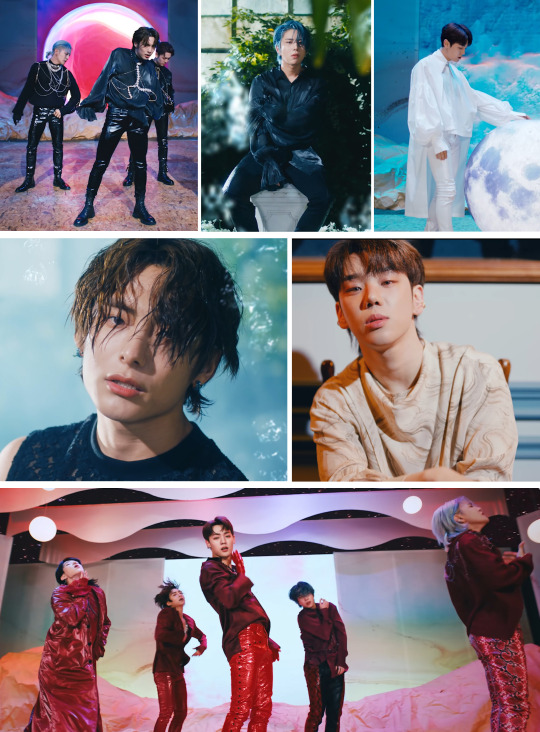
there are also several instances of scale patterning and wetlook hair styles, further elabourating on the siren theme. and the jewelry is the same, purposefully cut clear stones for oceanic sparkle or pearls, the gem directly born from water, as highlighting accents to specific parts of the body - namely eyes, hands, and torso:
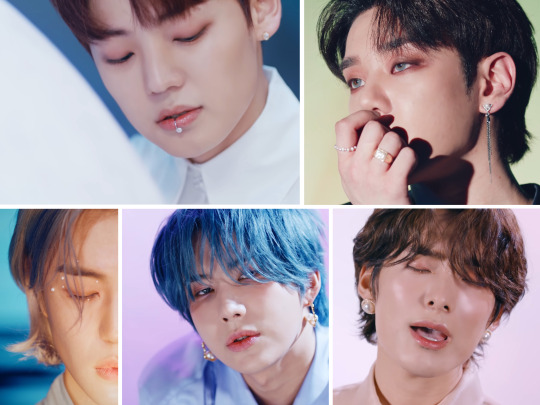
the body jewelry also serves a double purpose in addition to being sparkly; it gives a semblance of shape to their torsos so their movements aren't totally lost in the shroud of their shirts, and it also invokes some of that salacious element that us as a modern audience doesn't necessarily perceive in the same way when we see a man wearing only a shirt. all of these points are especially prominent in the stage costuming. concerning the veils, these are an aesthetic choice following the theme of depicting water without actually using water. the song has a very breathless quality to it, and the lyrics directly make reference to water and breathlessness, so it only makes sense to have a physical manifestation of struggling to breathe.

now let's talk about
mise-en-scène
unlike most kpop mvs, I would argue that higher is not a spectacle in what we normally see spectacle to be. the overwhelming visual saturation of goblin (and the goblin remix) is more in line with what we expect, but how do you follow that, top it? the answer is that you don't. you aim for something with a completely different feel, which is exact what they did with higher.
the performing arts did not escape romanticism. the very start of the movement, sturm und drang, is actually named from a specific play written by friedrich maximilian klinger that premiered in 1777. the plays of the brief period are characterized by extreme and passionate emotions, and were siblings to one of the most famous genres of theatre, the melodrama. meant to appeal directly to the emotions of the audience using sensationalist plots and stock characters, the melodrama was the predominent form of entertainment in victorian england and gradually developed a specific form of its own. in this period we also start to see the development of 'stagecraft' into the recognizable form that it takes today. footlights, limelight/spotlighting, the separation of house and stage lighting, fly galleries, elevator platform mechanics, and the first (purported) western use of rear projection are all innovations of the late 18th and 19th centuries, as melodramas were known to have very intricate and spectacular stagings. and to go along with these stagecraft mechanics we see the rise in designated stage crews, which were predominantly off-duty sailors looking to make money. the rope systems that made up the fly galleries were very similar to that on ships, and much of the terminology and supersitions crossed over: this is the origin of the term 'rigging' being used for suspending set elements, and also the origin of the 'don't whistle in a theatre' superstition. as sailors communicated with whistle patterns on ships, the same system was adopted for changing scenery, and therefore whistling a random pattern could potentially drop a setpiece on an unsuspecting victim.
so with all this backstory out of the way, what is the very first full location we see? a stage, complete with forced perspective via the painted fabric legs (the side panels) and borders (the wavy upper panels). we even have a flat painted backdrop with a projection screen and hanging overhead lamps. there's also a second interior set, a desk in what looks to be a study of some kind. bit self explanatory on this one, taking the poet notion on the nose.

the locations have a bit of an obtuse arc, but it's there when you look for it. it starts interior spaces, where the ideas of sublime attempted to be recreated for the viewer. then it moves to transitory spaces; portions of nature isolated from a whole environment, interjections of human architecture into natural spaces:
(the white hut structure in the greenhouse is reminiscent of a skene (literally hut/tent), which is the structure at the back of the stage in ancient greek theatre used for the actors to change their masks and costumes. it was originally temporary, but slowly transformed into permanent stage architecture)
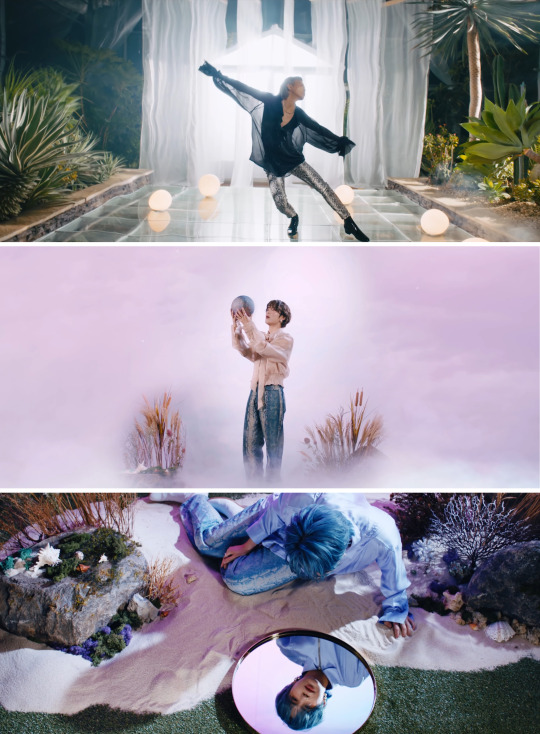
and then finally outdoors, into the sublime itself:
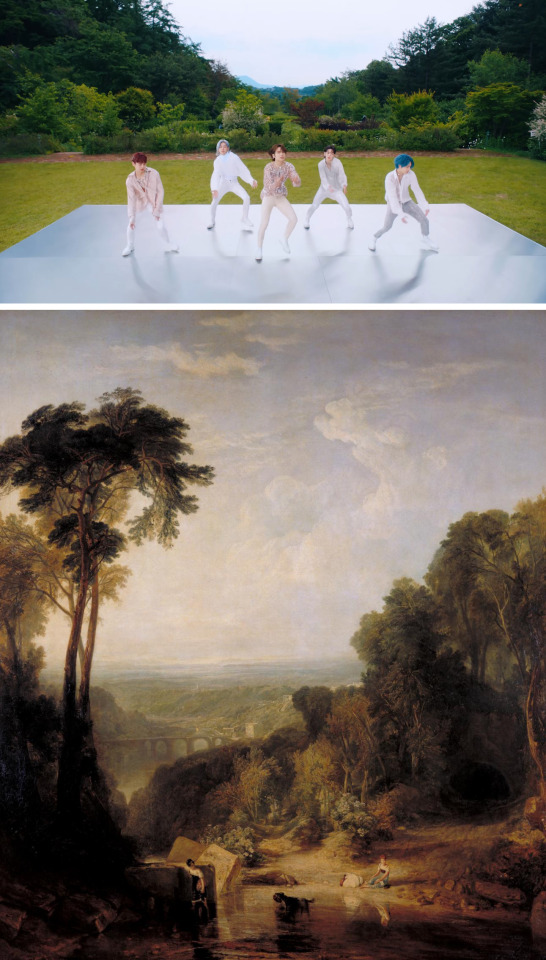
jwm turner, crossing the bridge, 1815
lastly,
lighting
there's a very clear lighting pattern here, primarily in light and dark. the base colour story is fairly simple complementary pairs; there's a lot of purple/red and green, and blue and yellow/amber, with everything relatively on the same tonal level. there are deliberate interjections of heavily saturated red for specific effect. there are also, most notably, a 'dark' version of all the sets. obviously as a reference to the eclipse that we see in the mv and in the concept photo series, but also as a reference to that darker undercurrent of the sublime, the upsetting, the uncanny, and the terrifying:

And the bay was white with silent light/Till rising from the same/Full many shapes, that shadows were/In crimson colours came.
#a.c.e#ace w#kpop analysis#group analysis#me - a staunch defender of kpop as valid spectacle: actually this one is a melodrama its meant to hit different#this essay is otherwise known as the quickest and dirtiest history of romanticism ever#i really should have pointed out that when i say romantic i mean romantic with a capital r#that probably would clear up some confusion but i have an aesthetic to maintain do not @ me#this is potentially the most pretentious thing i have ever written i am so sorry if this makes no sense#some of these connections are so tenuous who let me have opinions on the internet#did i write this as an excuse to look at the percy shelley memorial because i am obsessed with it as a piece of art? maybe#anyways read tom stoppard's arcadia if you want to know more about that#you should read all this with the caveat that the sublime and romanticism need to be deconstructed through a postcolonialist lens#because these theories are super colonialist about 'unclaimed untameable natural spaces'#when in reality most natural spaces are specifically architected by indigenous peoples in order to preserve and coexist with the ecosystem#this is may be more obviously applicable to american subliminal painting than european but it still applies#since the british were notoriously good at fucking up every kind of expedition ever#because of their lack of respect for literally anything and everything#and their inability to listen to anyone other than another white british person#see: history of the northwest passage#im a bad theorist and not caught up so i didnt get that deep into it because counter to the wordcount#i am not trying to write another dissertation#this is not as well researched as it could be but also im not reading burke and kant again#also yes byron the shelleys and polidori did just bang out the foundations for all of science fiction and romantic vampire mythology#in like three days because the all got bored during a storm and want to try and 'outscare' each other#also by 1840 like every prominent romantic poet was dead either from their own stupidity or tuberculosis#with the exception of wordsworth that motherfucker started the movement and then outlived it#text
17 notes
·
View notes
Text
final kingdom rankings
i decided to do the dumb thing that took too long and ranked all of the kingdom stages based on my personal opinion and ranked my top 7 over all (unit stages included). once again this is an opinion and i’m more then happy to discuss other opinions on the stages, but don’t use this post to bash me or others if it differs from your own. this will include notes on both the performance and the music itself.
with that said i’ll keep it under the cut as this will probably be a long post (spoiler: it is </3):
quick note: i watched all the stages by group and each stage in chronological order as i was taking notes. there may be some repeats of things or i bring up something that’s in a lower ranking stage if a higher ranking stage was one of the more recent ones (hope that makes sense). also if you don’t want to read everything there’s a top 5 ranking and my own final group ranking at the bottom.
skz:
stage 3 - i’ll be your man: seungmin and jisung vocals!!! i’m still not too familiar with the original btob song so i’m not sure how skz’s version varies from it, but their version i think fits their team really well. chan took a little bit of a back burner this stage, but we really got to hear the vocal side of skz shine through this song esp in their lower register which i think it stronger then their upper one lmao. jisung is really the only one (that i think) can belt some of those high notes so consistently. on the actual performance side of things there was an interesting use of sets and props, but not over done. there were some really ineresting dance breaks esp at the end of the song. the story of the stage was also i think one of skz’s strongest (and no guns <3). i really hope skz does a song like this in the future cause they can obviously pull it off.
stage 2 - side effects / god’s menu: really loved how we got to see a different side of skz on this stage with their acting! i don’t think they had another stage that was quite like this one. also loved the mixing again with both side effects and god’s menu with how they used felix as the transition between the two songs, and the FAT synths during the ‘my head hurts’ right before going into god’s menu. while this is a strong stage musically, acting and energy wise. i feel like there was too much of a reliance on props and a lot of work was done by the dancers which was visually amazing!! but skz is a strong dance group too and i wish it wasn’t as flashy as it was.
final stage - wolfgang: this stage and their 2nd stage are honestly tied but i think wolfgang is slightly lower cause i prefer the mixing for the 2nd stage. really dissapointed there was no epic organ player that was killed at the end </3 but that aside i would say wolfganf is a just a really strong skz song that’s a little more in the 3racha style. i really liked how they tied in some of the points from their intro stages with the green mouth light things and some of the samples used in the track! the reason it’s middle of the pack (haha get it cause their wolves.....i’ll stop) for me is similar to the side effects stage as it relies a lot on their dancers and props. it was a really nice ending performance to end their time on kingdom. (also one of their most messiest stages, but it was probably the one with the least amount of time for practice with everything lmao)
intro stage - miroh: really great intro stage for the skz cause we really got a taste of what was to come with kingdom (sadly no jinnie). the mixing was insane and one of my faves i think for skz (esp minho’s part <3). it had the same height of energy as the original tack, just much darker, and there was decent balance between vocals, dance, and rapping. it also showed their great work as a team with the small stunts in the choreo.
stage 4 - god’s menu x d4: don’t get me wrong, this stage is really neat with the deadpool stuff, but it’s also a stage that won’t really age that well? it was more on the gimmicky side of kingdom stages and i’m not sure why they had a large chunk of the choreo with guns???? that’s not needed that you. going into the good things...binnie popped off!! he really stuck out to me this stage rap wise. also the drop for the first d4 chorus was very unexpected but also really satisfying? kinda reminds me of the drop in the chorus for 1team’s ‘make this’ (go check it out if you don’t know the song). over all a really fun stage and their energy was really good, but just wish it wasn’t quite and gimmicky as it was </3
ateez: man i miss mingi....comeback soon king
final stage - the real: ok this stage is also really really close to their wonderland stage but is just SLIGHTLY ahead it. this stage was probably one of the most fun ones to watch out of ateez’s kingdom performances because they seemed so loose? like they were really just feeling themselves on this stage and it just looked like they were really enjoying themselves out there like this is what they were born to do. i also love this song and it’s one of my fave recent releases from ateez again (i’m not too big of a fan of their fever series sorry </3). the energy, rap, vocals, choreo was just all there. i’m just really glad we were able to see one of these stages again where we go to see the group really just let loose and half so much fun performing before the end of kingdom.
stage 2 - from the wonderland: look...i KNOW there’s a tentacle, but i’m going to look past that. it might be the favoritism towards wonderland as it is one of my top ateez titles, but i think it they did do a really good job mashing it together with symphony no. 9. there was a decent balance between using props/reliance on dancers and the group actually dancing. jongho slayed that high note at the end, and it was actually placed well in the song where it didn’t seem out of place. and them the OUTRO just represents one of the main reason’s i love ateez with their amazing energy. high energy song, high energy choreo...just the perfect ending to get you hyped. also one last note....seonghwa looked so hot when he was walking through the line of dancers with that rifle (he just looked good this whole stage <3).
stage 3 - the awakening of summer: a very different style from the original and i’d say even a different style for ateez but it still works?? the beginning was a lil cheesy and not sure how the whisper talking/rapping through most of the song works for me, but the INSTRUMENTAL pls play it at my funeral...that synth line <3 i really liked the little choreo with the rope that san did and the overall choreo was also really strong. the outro was a little let down on the energy of it. it may be cause there was some slight timing issues with the vocals and backing track or they were just missing SOMETHING for it, but jongho slayed that belted note once again where i’m not too mad at it lmao.
stage 4 - answer: in the first half i really thought this was going to be one of my fave stages for ateez as the added strings were a nice touch and i loved how they made some references to their past songs and overall concept story line. overall musically in the first part it was decently balanced with a few ode to joy and answer. once it got to the part where it was the opera singers i was????? if they stopped there i think it could have still worked, but the ending there was just so much going on but it was also missing so much as well?? i didn’t understand jongho’s one belted note at the end. this was the only stage where i really felt it didn’t fit. they either needed to not add it at all or have him have one other note after it with maybe a break between the two notes to make it feel more complete. overall...a decent stage, but it really just didn’t have that ateez polish on it.
intro stage - wave: ok tbh i....kinda hated this stage? NOTHING on ateez or wave, just the song did not translate to the style they ended up choosing for it. i think say my name would have been a really strong intro song in the final style chose esp since it didn’t come up in their later stages. the choreo was really strong, but honestly the mixing just seemed like they forced two pieces together that didn’t fit.
the boyz: ok i just want to write a quick note as a general opinion i have across all their stages. tbz is a really solid group overall esp with dancing, but i feel like for kingdom they played it safe in a lot of ways and we didn’t see much variation of wow factors from their stages. they were good!! just (usually) fairly predictable like they set the bar high and then just never raised it again </3
stage 4 - monster: this ranks so high partially cause i love exo’s monster sm but besides that point </3 the vocal line seemed to be pretty much a copy paste from the original (not a bad thing at all) but once again the instrumental my beloved <3 i think because the vocal line was pretty much the same as exo’s made it a really nice balance between the original and tbz version. i wasn’t too sure about the giant snake towards the end, but it actually wasn’t too bad as it was more of just the use of an entrance, then just a bg prop after that. as with all of their stages, the choreo was really solid, but it was the arrangement of the song that really put this performance on the top.
final stage - kingdom come: dance wise i think this is my favorite out of all their stages. they had neat transitions from their pre recorded parts of the stage and the live part of the stages. really liked the part where the hand off screen was controlling the chroeo. then the dance break/outro!! not sure what it was, but i think it just really highlighted their strengths in dancing as a group. the song itself didn’t stand out at all and i think that’s why it ranks lower then their monster stage. it sounds a lot like checkmate to me (possible blended with salty???) so it’s a solid track, but it just doesn’t sound that different from their past ‘finale sounding’ tracks. it was a nice stage to end on for them as it was really solid, and it capped of their time with the kingdom series well.
stage 2 - no air: tbh the orginal song for no air doesn’t do much but i LOVE this mix of it. it might be the slowdown of the chorus that really does it for me, but it’s one of my fave mixes for their stage. really solid choreo and i liked the paired dancing with the other dancers in the first chorus. i think tbz i one of the the better groups when it comes to non-power dancing....not sure how to word it, but they’re very graceful and i love when they show it off and the dancing in front of the white fabric was a really nice touch. they also pulled off their stunts really well!! that’s another things they’re pretty reliable in, but it’s something they don’t overuse which is nice. a very strong stage overall for them.
stage 3 - the red wedding: someone is going to murder me for this, but i’m not the biggest fan of o solo mio </3 tbz did a really good job with the song! music wise for me is just that the rap sections i think didn’t flow too well in their rendition of the song. i don’t remember how they fit in the original but it didn’t fit that well in this stage ;_; i thought the rest was really good! their use of props wasn’t overdone and added some interest to the choreo that was already really strong. also really enjoyed the sections in the birdcage with the female dancer. another really solid performance by them.
intro stage - the stealer: LOVED the choreo and formations for this performance. they’re a really strong dance group and i’m glad we got to see how good their dancing is with no props or anything. the song it’s self wasn’t too special, it was a solid mix but it seemed like something we’ve seen before? i think it reminded be of one of their stages from rtk, but i don’t remember which one ;_;
sf9:
stage 4 - move: CONGRATS TO SF9 FOR BEING THE ONLY GROUP THAT HAS TAEYANG. i could watch that man dance all day damn. the only thing i didn’t really like/understand was the very end where they were standing in the rain??? it would have been neat if they had one final dance break in the rain box or a solo dance or SOMETHING...it just didn’t need to be there otherwise </3 but everything else was SO GOOD. the concept of the stage was strong, the mixing was fit the group really well, and with move being such a difficult dance, the members did a really good job with it. the props/sets used i think added to it, and there was a good balance between those and the group actually dancing. glad to know taemin covers in the kingdom series did the original songs justice <3
final stage - believer: taeyang once again <3 overall the track sounds like a really solid b-side, but their performance really brought it up to a nice finale song. loved their references to their past stages with the props and formations with the dances, it wasn’t too much and didn’t distract from the rest of it. the use of reflections was also really well done!! that prop was super cool and loved how they played around with it. overall a really nice way to end kingdom for them, and i think dance and staging wise, it was one of my faves to come from them.
stage 3 - the scene: congrats sf9 for being the only group that has hwiyoung <3 tbh this stage would probably be my number one of they didn’t have the guns during the choreo </3 it just...brought it down so much for me (and the blurred out knife???). i think the mixing was pretty solid as it was close to tbz version, but made it fit sf9 really well. the fight scenes were super well done and i feel like did add something to the stage. then overall the dancing was really sharp this time around!! a super good stage....just take out the dancing guns.
stage 2 - jealous: this was one of the few stages outside the introductions that didn’t have a super heavy reliance on props, they didn’t rank well, and then we never saw a stage like it again </3 i loved this stage!! it didn’t change drastically music wise, but i really liked the kind of rock style? remix of now or never and it fit well with the concept of the stage. the formations!!! in this performance were some of my fave and loved the bits of choreo we saw when the members were dancing with the female dancers. there were some parts with the members weren’t quite in sync with each other, but overall it was really solid and sad we didn’t get to see a stage like this one again ;_;
intro stage - good guy: if sf9 just did suit concepts in the future i would not be mad <3 but overall a solid intro stage! there wasn’t much difference music wise except in the dance break in the beginning from the original song. choreo was pretty crisp and overall done well. there were no ‘wow’ factors in this stage, but a very solid one overall.
ikon:
final stage - at ease: tbh i wasn’t too sure about the song in previews, but it’s grown a lot on me as this past week went on. it’s a great hype song and has the energy of ikon that i really love. the drop the in the chorus is really satisfying and it was just as satisfying visually in the performance as well. they used their dancers really well and the members also did really well with the chorus choreo. it was just overall a really satisfying stage for ikon and it was the only stage in my opinion they ramped up their more laid back energy and worked so well.
stage 2 - to the world: this is one of the stages that really does age pretty well. i wasn’t a huge fan of it mainly bc of the ending and it’s still not my fave but it didn’t take away as much from the stage as i remember. i LOVE both love scenario and killing me. the love scenerio portion of the stage i think it still one of my fave ikon moments. the acting was solid and i liked their story with it. in some ways i wish at least killing me was a little more hard hitting and less a copy and paste for the most part from their original. love scenario was an amazing opening but killing me needed something to make a solid ending song as it caused the energy of the stage to kinda fall off or not really raise at all. overall i do really like this stage, it just needs more of something for the ending.
intro - rhythm ta: i think this was my 2nd fave intro stage right being skz’s. i love the formation in the beginning and the vocal fry on the ‘ikon is back’ was a nice touch. it also just seemed like the most loose intro stage? like this wasn’t their first rodeo and just felt really comfortable on this stage. overall loved the energy of the stage, and there was solid mixing of the song and good choreo.
stage 3 - inception: this isn’t hate on bobby or anything but his rap parts really bought this performance down for me </3 it might have just been an off day or smth but...yeah. otherwise i really liked the stage!! the mixing was really intresting and they really made inception into their own ikon style. the sets used was also probably my fave overall? it was really really neat with the changing sets to match the song title. also the ending was super cool with the dancers in that final formation where they kinda slowed down. a really cool stage overall.
stage 4 - classy savage: family watching yg tv time <3 i think there was a really nice balance of both the original bp song and ikon’s style. tbh it seems opposite of what i said with the boyz..the insturmental seemed pretty close to blackpink’s, but the vocal/rap was very much the ikon style. the reason this one is so low for me is because it seemed like two separate stages with lisa? it was really neat that she was added, but it would have been so cool if he joined in with them for the final outro or something. she even had the same lyrics to the blackpink song as ikon’s changed so it just made it that much more separate. if lisa either joined in more with ikon or she wasn’t added at all i think this would have ranked a lot higher on my list </3
btob: another quick note....i think on the performance end btob is the opposite of tbz. they don’t do much with choreo but they’re such an enjoyable group to watch and their VOCALS are always so stable so i probably won’t have many notes on their dancing lmao
stage 4 - blue moon: concept and comedy kings <3 idk they were really feeling themselves but it looked like they were having so much fun on stage and it made me have a smile on my face the entire time. the concept of the movie worked so well with the style of the jazzy tune. i’m not too familiar with the original bside so i’m not sure how much it differs or if it does at all. there’s really nothing i would change from this stage...it’s just so enjoyable to watch from the concept, vocals, and peniel playing that piano terribly <3
stage 3 - back door: really close to their blue moon stage for me. i really feel like they got the hang of the kingdom stages at this point. i loved their remix of back door. they took a rap heavy song and turned it in to a vocal heavy one so well?? truly made it their own. the weird drop(?) after they say back door just works so well for me and the inclusion of the electric guitar is so NEAT. there wasn’t much as far as dancing except for the small bit at the end and in one of the ‘dressing rooms’ but it really worked for the concept of the stage. idk it’s just a really fun stage to watch and a really good hype energy at the end.
final stage - show and prove: TALK ABOUT A FINALE STAGE. i love this song on it’s own and it’s probably my top song or in the top 2 for the original kingdom songs. this stage is another one that’s so close with their blue moon and back door stage, but i think it ranks a little lower then the other two as there was choreo from the members (or at least not a lot at all). but even with that this stage didn’t feel any less grand then the other finale performances because they killed the vocal parts so much and the song itself is such a GOOD ending song. oh man i would rate this higher if dancing or concept also was involved ;_;
intro stage - beautiful and painful: (i think that’s what it’s called?): vocal kings <3 they really said we’re the best vocalists on this show with this intro and you know? they’re correct. i wasn’t too sure on this stage when i first watched it since it was so different compared to the other groups, but watching it again now it’s a really strong intro stage. btob is a really strong vocal group and they established that really early on and only gave us a taste of what they were really able to do. a great intro stage overall.
stage 2 - missing you: overall the stage is really beautiful with the lighting and the trees, but similar to ikon’s stage with lisa it seemed really disjointed. the vocal sections were really strong on their own and the dance break section this was really cool on it’s own, but it didn’t mesh together super well :/ a decent stage for sure, i just wish they kept the style of the dance break or just kept it the style of the vocal stage. i think they might have just added that dance section in there as the other groups had such dance heavy performances and theirs didn’t, but again it just kinda took something away from it </3
unit stages: i’m not going to write notes on the unit stages cause i’ve already written so much on the group stages lmao but if you want to more about/wonder why one ranked lower then another than pls ask! i’m just too done with this post to write it now. i will say 2-4 are really close in ranking. love poem took the whole thing for me and i wasn’t a huge fan of wither rap unit stage </3
love poem
wolf
king and queen- both performances teams are really close in ranking after a rewatch
spark
colors
full dash
top 7 stages overall: cause i couldn’t choose 5 </3
love poem (i think it’s cause minnie brainrot but we’re not going to talk about it thank u)
i’ll be your man
blue moon
the real
from wonderland
side effects / god’s menu
move
final group rankings:
stray kids (call it favoritism, but they deserved it)
ateez
btob (if kingdom was only vocal/music they would have won in my opinion)
sf9
the boyz
ikon
#ok it's finally done </3#i hope someone reads this or it sparks a conversation ajshrdsdr otherwise i spent 4 hours just reliving kingdom#it was interesting to see how all the stages#ended up being#and it really seemed around the 3rd round all the groups found their groove and then it got really really good#also this is not proof read to sorry if there's some mistakes
16 notes
·
View notes
Note
3. Do you have any upcoming WIPs? How far along are you with them? + 4: Tell me about one of your abandoned WIPs. Why did you abandon it? + 5: Share a snippet that you’re proud of from an upcoming fic/chapter. + 17: What has been the proudest moment for you so far since you started writing? ---- Sorry, i am very curious :D
Thanks for asking! Questions are from this list, if anyone wants to send any more!
3. Do you have any upcoming WIPs? How far along are you with them?
The two I’m currently focusing on out of my sea of WIPs are what I’m calling the ‘twin bastard WIPs’: aka, the grotesque fic and ‘variations on a redemption arc 1′. I’m calling them that because they’re both similar despite being in different fandoms. They’re both about the same length, they both deal with dark themes (including torture, always fun), there’s a lot of overwrought emotional conversations - and I was having the same problems with them. Specifically, I’d put them aside and let myself get distracted by other works and then when I picked them back up I would have like...the same series of revelations every single time. Like, ‘oh I should do this and this, and THIS is the real motivation for this character behind the mask.........wait I’ve already done this.’ So I decided to just focus on these two until they were finished, which is going...umm...okay. (There was not a ‘variations on a redemption arc 2′ when I made this pledge and then wrote three pages of it in a notebook...)
I would say I should be done with both by the end of the summer? Hopefully? well, the grotesque fic has a deadline now and I’m making good progress on the other (though I have fight scenes left to write blegh I always procrastinate writing fight scenes).
4. Tell me about one of your abandoned WIPs. Why did you abandon it?
I rarely consider WIPs abandoned. Either they were never really WIPs to begin with, just snippets of ideas and dialogue I had no intention of expanding on in the first place, indulgent scenes I just wrote for myself, or I still have hope to finish them. Two slightly longer ones though that I would call abandoned:
- last year to combine a whumptober prompt with a bad things happen bingo square (hunting season + surrender) I started a Star Wars fic but the worldbuilding never came together and I subsequently learned there’s an arc of The Clone Wars that did almost the same thing (one day I will actually watch The Clone Wars....it is not this day, though I do have a friend who might bully me into it soon) so I just scrapped it.
- I had another earlier version of the ‘Team Revengers on the Ark’ type semi-episodic fic, but I ended up pilfering some individual scenes for ‘pain and other human sensations’ and I ended up liking where I went with that a lot better (even for things that didn’t affect the larger series plot, like the Grandmaster’s return) and never really cared to go back and continue this version
5. Share a snippet that you’re proud of from an upcoming fic/chapter.
from ‘variations on a redemption arc 1′
“You’ll let him die?”
The thought of it leaves him momentarily breathless. But he still says, “Yes. I would let him die a Jedi.”
Silence falls between them. Qui-Gon expects Dooku to leave. But he doesn’t.
“I cannot deny,” Dooku says after a few minutes of quiet. The roar of pain has dulled to a steady throb. “That once I would perhaps have answered as you did. That I would have perhaps had the sense of honor to let you die rather than fall. But I have watched too many Jedi cut down in service of a mission that failed long ago, and I will do it again.”
file this under, ‘willing to put up with writing 3 separate fight scenes because I am in love with this one exchange’
[additional note: the second ‘variations on a redemption arc’ isn’t actually a sequel but just another fic along the same lines, with some divergences, which is why I really want to finish this one first, because first of all I keep getting distracted and losing track of the complicated emotional and political motivations, but I also don’t want to mix up themes since they’re taking place at very different narrative points. it’s just a funny placeholder title haha, because the other day I was like ‘wait isn’t this just another variation on the same narrative’ and then was like ‘eh, two cakes’]
not from the grotesque fic, but the conclusion to an accidental trilogy about ghosts and hallucinations:
“You see, in this I preferred the old Thor. He’d spare me these sorts of conversations, bury it down deep and act as if nothing’s wrong.”
Thor’s gaze is level. “You’re asking me to act like nothing’s wrong?”
“Yes.” Loki would vastly prefer never to have this conversation. He’d much prefer that Thor dismiss any of his new oddities as simple quirks and let him suffer in silence until it all fades. He turns back to his counting. 5…10…15…20…
“I know you’d prefer to avoid this talk, but see, that’s what got us in this mess in the first place, brother.” Thor sounds weary. “I let you suffer in silence until it didn’t fade, until it all blew up in my face. And you ask me to do it again? To repeat history?”
Loki stops counting cans. He was certain that he had not said any of that out loud. He turns and opens his mouth, but before he can demand an explanation, Thor says, “How’s the inventory coming?”
Only the Thor he was looking at hadn’t said anything, and the voice came from behind him.
Loki turns. Thor stands in the doorway, looking at him with an innocent smile on his face. Loki glances back to the crate where his brother had been perched. It is empty. He turns back to the Thor in the doorway, face feeling very cold and something unpleasant in his stomach. “What?”
“How’s the inventory coming?” Thor asks, a bit slower this time.
This was just the first piece I wrote of this conclusion, still far from making any decent progress on it but I like it!
17. What has been the proudest moment for you so far since you started writing?
Tie between 1) any jokingly angry comment (like obviously not any actual nasty comments but the ones where people are like HURTS SO GOOD) 2) actually scratch that, when I finally got the first ‘you’re disgusting’ comment on one of my extremely rare actual Thorki fics, I was pretty proud of that too 3) any time I get to a place where I read back a fic of my that I’ve posted that hasn’t gotten a ton of comments or kudos and I’m like ‘hell yeah this is fire, I don’t care if the readers don’t appreciate you, fic, I appreciate you’. Which might sound sort of full of myself but it’s always a nice place to get to where it’s like...hey the validation is nice but also I just really like this work. wrote it for an audience of one, me, and me is happy so that’s a win.
Feel free anyone to send more asks! I will theoretically answer them at some point this evening as procrastination from actually writing
#idk why I get so cagey about sharing snippets of my star wars fic#i think i'm still weirdly waiting to get cancelled or bullied out of the fandom for some reason haha#even though people have been super nice even though i'm writing in a smallish niche#but yeah idk why i think i'm just...too emotionally wrapped up in it right now haha#so every time i post a star wars snippet i throw out an mcu one as a distraction/cushion for it to land on if that makes sense#deep insecurities about my star wars fic babies but i also love them so much#thanks for asking!#long post
9 notes
·
View notes